successes
Updates and New Releases
06/27/24
We are excited to let you know about some recent enhancements we’ve added to Leo! These updates are now live in your production environment. Please let us know if you have any questions or concerns.
Custom Colors for MSPE Charts
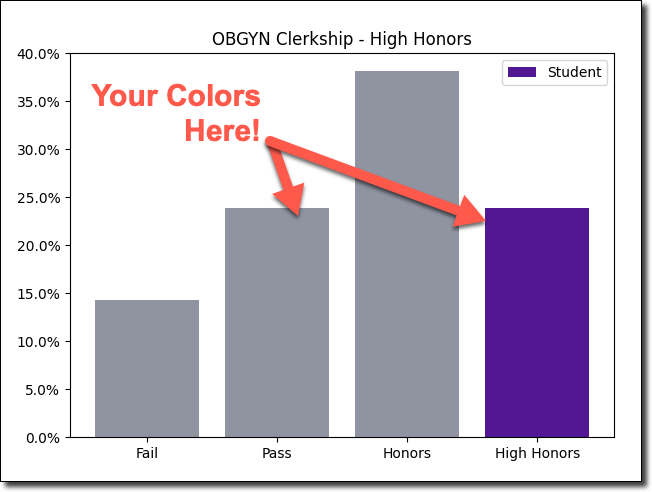
You now have the option to change the colors used for the Comparative Analysis bar charts generated by the MSPE Assistant in Leo. Many schools like to represent their brand within the MSPE letters they generate. If you would like to change these colors from the default, please contact us via the help desk. We’ll need the HEX codes (e.g. #4A1985 is the purple color in the image above) for each of the colors you want to utilize.
Due Date Option for Eval Reminders

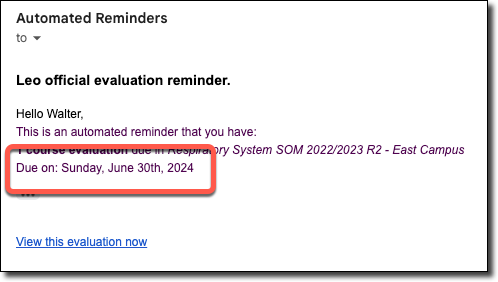
We’ve added a new option to the Account Manager that, once enabled, will allow you to include a due date for all of your evaluation reminders. This option is not enabled by default. To turn it on, navigate to the Admin Toolbar > Advanced > Account Manager > Modules > Evaluation Settings > [Program]: General Evaluation Settings > [check the box for Add evaluation expiration date to reminder emails].
Assignment Reminders for Events
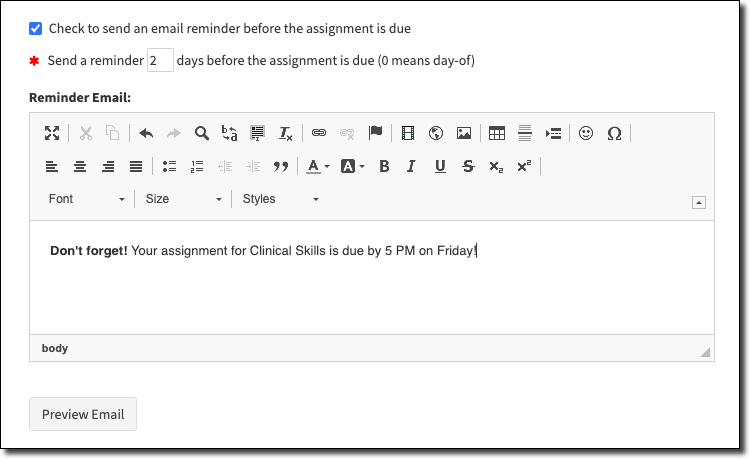
One of the features many people loved about Long Events, was the ability to send a reminder to students when an assignment was due. Now, you’ll have this same option for all assignments in all events in Leo. When editing an assignment, you’ll see a checkbox for Check to send a reminder… Select this option and enter your custom message to remind students about the assignment the specified days before the assignment is due. Refer to this article in the Leo User Guide to learn more about assignments.
More Information for Finalized Gradebooks

Now, when finalizing a gradebook in Leo, we are including the name of the user who finalized the gradebook. This is for information purposes only and does not affect any other gradebook features. Keep in mind that the “finalized” flag is not visible to students, only to staff, faculty, and administrators. Please refer to this article in the Leo User Guide to learn more about finalizing gradebooks.
06/13/24
We wanted to make sure you were aware of a few updates to Leo, including a new option for copying events. These updates are all now live in your production system. Keep reading to learn more!
Copy Event Data
In case you missed it earlier this year, you can now easily copy an event in Leo from the Manage Events screen in a course. Now, however, you have an additional option when copying an event in Leo. You can copy all of the related data along with the event itself. For example, you can copy mapping information, materials, exams, etc. Just check the box next to “Copy associated data”.
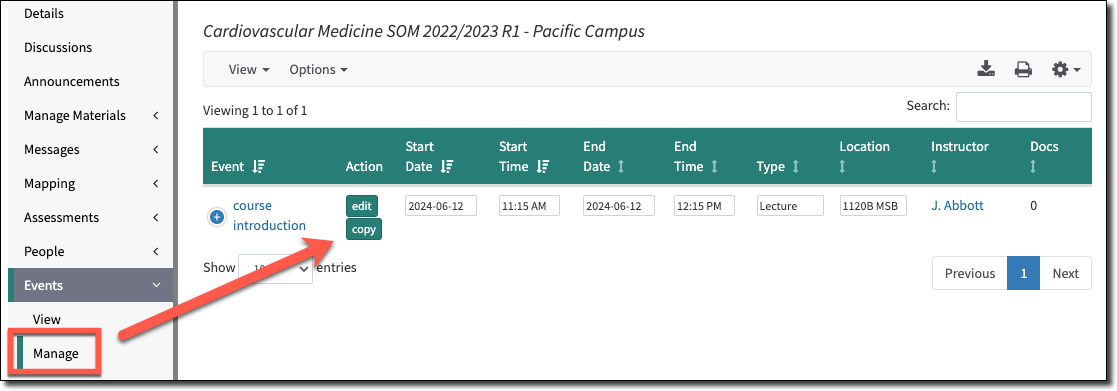

Other Updates
- PET Checklist: We corrected an issue that was causing the Patient Encounter Tracking Checklist at the section level (Assessments > PET > Checklist) to sort incorrectly.
- Small Group Sets: Now when deleting a small group set, you’ll be prompted if any of the sub-groups are used in other small group sets (or courses). You’ll need to remove those groups using the “add groups” or “add groups by year” option. Alternatively, you can click on manage groups to remove any groups you no longer need. Read more about this update in the Leo User Guide.
05/28/24

Dear Colleagues,
You are charged with one of the most challenging tasks facing our society today: educating our future healthcare professionals. The results of your work impact everyone – our parents, our children, our partners, even our pets. That’s why, as we step into the future together, we are more committed than ever to your success.
For years, DaVinci Education and Elentra have focused on supporting effective teaching, learning and assessment across the health professions, driven by our strong foundations in the academy. This morning, we announced the merger of our organizations. By combining our unique, substantial strengths, we are poised to create an ecosystem that empowers you to leverage your data in ways never before possible - and the results can be transformative. Imagine a world where you can:
- Anticipate and address challenges before they arise
- Identify and act on real-time opportunities to evolve and improve your program
- Optimize your resources to maximize outcomes for learners and educators
This is not just a vision; it’s the strategic reason our two organizations are coming together now. Our goal is to provide you with a next-generation guidance system tailored specifically for the unique demands of healthcare education. Our mission is clear: to support you in producing the most knowledgeable, capable, and proficient healthcare professionals of tomorrow. Together we can achieve even more as we continue to partner with you in this very important work.
This transformative journey starts from our deep understanding of the immense challenges you face every day. We want to keep learning from you so we can keep providing the tools and support you need to excel. The health of our communities - and the world - depends on your success.
Your future, in many ways, is our future too. We are filled with enthusiasm and optimism for that future as we embark on the exciting path ahead. We welcome you to connect with us at any time, and we look forward to sharing more about the powerful possibilities that we see taking shape for all of us as partners, together.
With our gratitude and respect,
John D. White, Ph.D., Chief Executive Officer, Elentra jdwhite@elentra.com
Allison Wood, Co-Founder, DaVinci Education allison@davinci-ed.com
4/1/2024
We are excited about some new additions to the MSPE Assistant. You can see these changes in your preview environment now, and they will be live in your production system this Thursday, April 4.
Make Bulk Changes with the MSPE Assistant
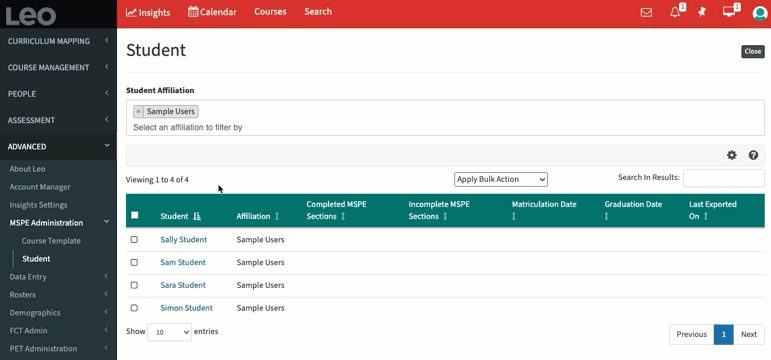
Leo now offers functionality to change students' matriculation and graduation dates in bulk as well as export MSPE letters in bulk. The new student report we released last month (Advanced > MSPE Administration > Student) now offers you the ability to see and update matriculation and/or graduation dates for selected students in bulk. We’ve also added functionality to export MSPE letters in bulk from this screen as well. Just click on “Apply Bulk Action” to use this new functionality.
Other Updates
We’ve also made several other updates throughout Leo to improve the user experience. The following updates are live now in your production system. Read below to learn more.
- We resolved an issue that resulted in Evaluation Reminder links showing up as expired when they were requested via on-demand.
- In the past, some web links with ampersands (&) or other special characters caused issues preventing these links from opening correctly. This has been resolved and web links should now all open correctly.
- We have corrected an issue that caused plus signs ( + ) to replace the spaces between event names at the top of Student of Faculty and Faculty of Student evaluations. Those event names now show up properly and we also added a line break in between each event to improve readability.

- After recent changes to the New Events User Interface, Leo was no longer respecting the default begin and end times set in the account manager (Advanced > Account Manager > Modules > Events > Event Display > Default begin minutes / Default end minutes). Now, if you have these settings enabled in the account manager the start and end time minutes will default to the selected values when you click into the field. If this setting is not enabled in the Account Manager, the minutes will default to the current time when you click into this field.
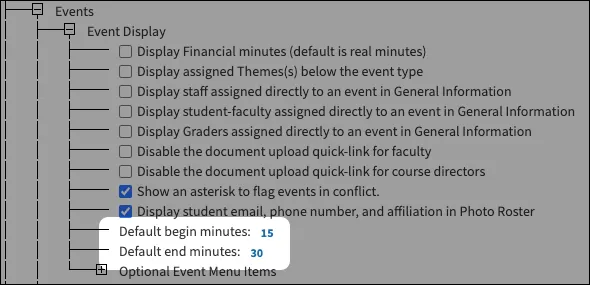
- Previously, if students had been individually added to any events (i.e., their individual group), they would remain enrolled even after being purged from a course. Now, when purging students from a course, you’ll get an option to confirm whether or not you want to remove the student’s individual group from events within the course.

If you have any questions about these recent updates, please reach out to the Help Desk, or reference the Leo User Guide.
3/8/2024
We’re excited to let you know about some recent updates to both the MSPE Assistant and the Manage Events report in Leo that we think are going to improve your workflows and provide more efficiencies for you while using Leo.
MSPE Student Administration Options
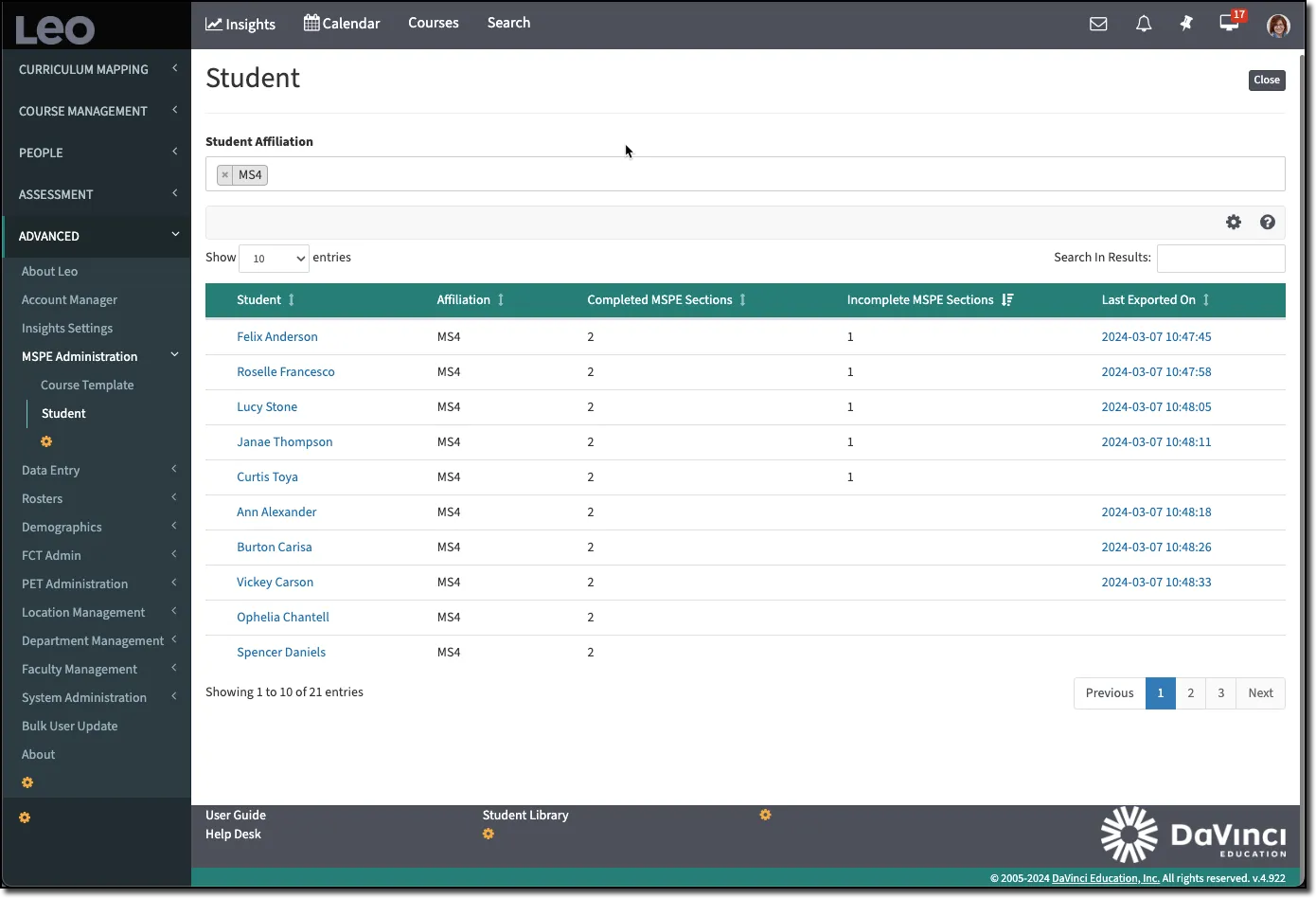
We’ve added a new student report to MSPE Administration. You can access this report by going to the Admin Toolbar > Advanced > MSPE Administration > Student. You can filter the report view by using the Student Affiliation dropdown at the top of the screen. This report also gives you a count of how many sections are complete/incomplete, as well as the ability to re-export the last document that was generated for a particular student.
Be on the lookout for more features coming to this report soon!
Copy Events from the Manage Events Screen

You can now easily copy events from the Manage Events report at the course section level in Leo. This report can be found by going to a Course Section > Events > Manage Events. Once you click “copy” from the report, you’ll see a “Copy Event” modal that you can use to adjust any settings that you need to change. So when you are adding a lot of events at once that may only have minor differences - you now have a much more efficient option.
Default Groups in the New Event User Interface

Now, when saving a new event using the New Events user interface, if the event type you’ve selected has default groups assigned, those groups will be populated in the event once you save the new event.
If you have any questions about these recent updates, please reach out to the Help Desk, or reference the Leo User Guide.
2/8/2024
This is to inform you that we have rolled out the New Event User Interface to your Production systems. We recognize that this is earlier than we previously communicated, but we're excited for you all to take advantage of this update that simplifies event creation and management much sooner!
We understand that some clients may have been anticipating the release later this quarter. As always, we're happy to support you in any way we can to get you up to speed on this update. We are also actively collecting feedback to continue iterating and improving this new interface - if you have feedback you would like to share with our team, please reach out to the Helpdesk.
Should you have any other questions or concerns please reach out to us! Here's a video guide summarizing the updates and more details about what this new user interface brings to Leo.

Re-envisioned User Interface
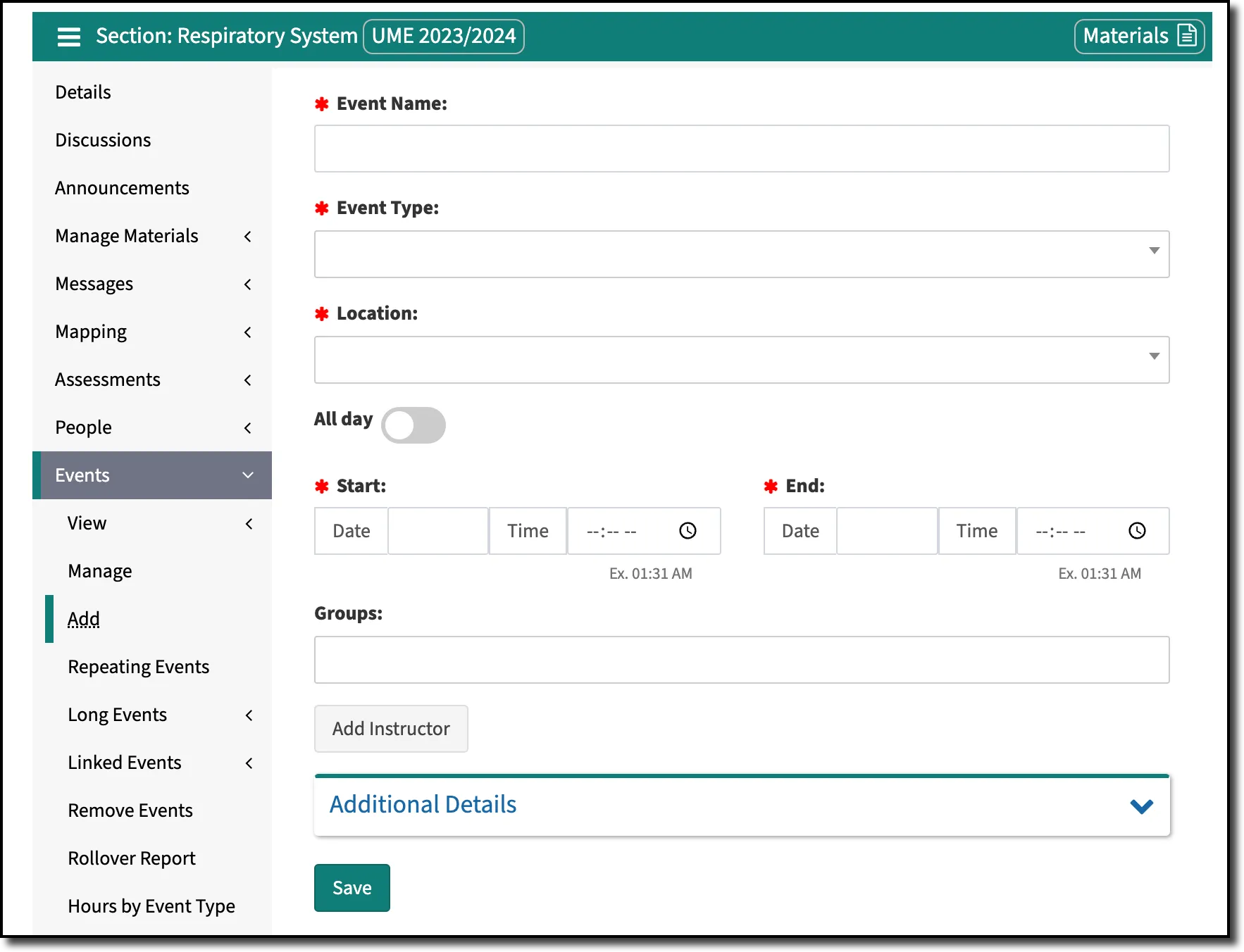
Adding a new event in Leo has never been easier, and you can now create all of your events from a single place! If you don’t want to designate a specific time for an event, just use the “all-day” option. All-day events can span a single day or multiple days, and they will appear at the top of your calendar. Essentially, the “all-day” event option replaces the need to create Long Events separately (more on that below).
We’ve even added options for adding faculty and groups on the same page. This should save you a lot of time when updating events and preparing for new courses in Leo.
Linked Events Makeover
You will also encounter the New Events User Interface when you are creating new Linked Event Templates and adding new Linked Events to your courses. Remember! Outside of the Event Name and Type, all of the settings for a Linked Event Template are optional. Any settings you do adjust on the Linked Event Template will be applied to all of the Linked Events you create.
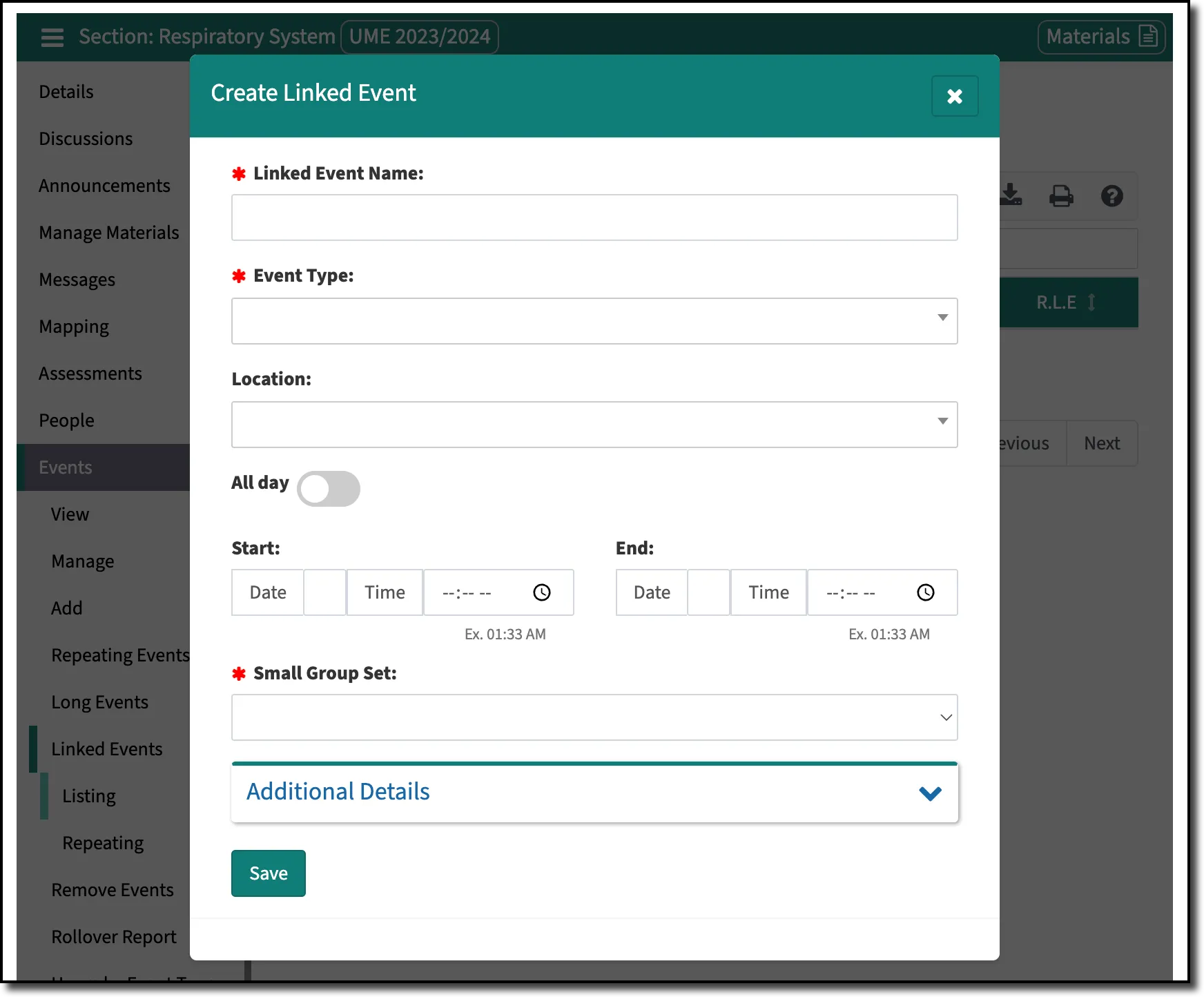
Additional Details
All of the settings you are used to are still available. Need to update the attendance or attire fields? Just expand “Additional Details” to make those changes and click Save!

Long Events
As you use the new events interface, you will notice it has much of the functionality and benefits of Long Events. As such, you should be able to use the new events interface for the purposes of creating those same types of events, as we plan to phase out Long Events from Leo.
Timeline
- This summer, we will begin with disabling the creation of Long Events. You will still be able to see and manage them in your system.
- In the Fall, we will begin to migrate and convert all your Long Events data into the new event format, which will work like any other normal event.
- Finally, in the winter of 2024/2025, Long Events will no longer be a feature available in Leo and will be sunset.
We will be in touch over the coming months with more information regarding the eventual sunsetting of Long Events and the conversion process. In the interim, we would highly encourage you to begin taking advantage of the New Events User Interface instead of continuing to utilize Long Events.
Session Objective and Event Imports
As part of this update, we took the opportunity to revise how the session objective import will function moving forward. Previously, a forward slash was used as a delimiter to map session objectives to a course or program objective. Due to the common occurrence of forward slashes in everyday language, we have modified this import to use a backtick (`) as a delimiter. This key is often found to the left of the number one (1) on a keyboard.
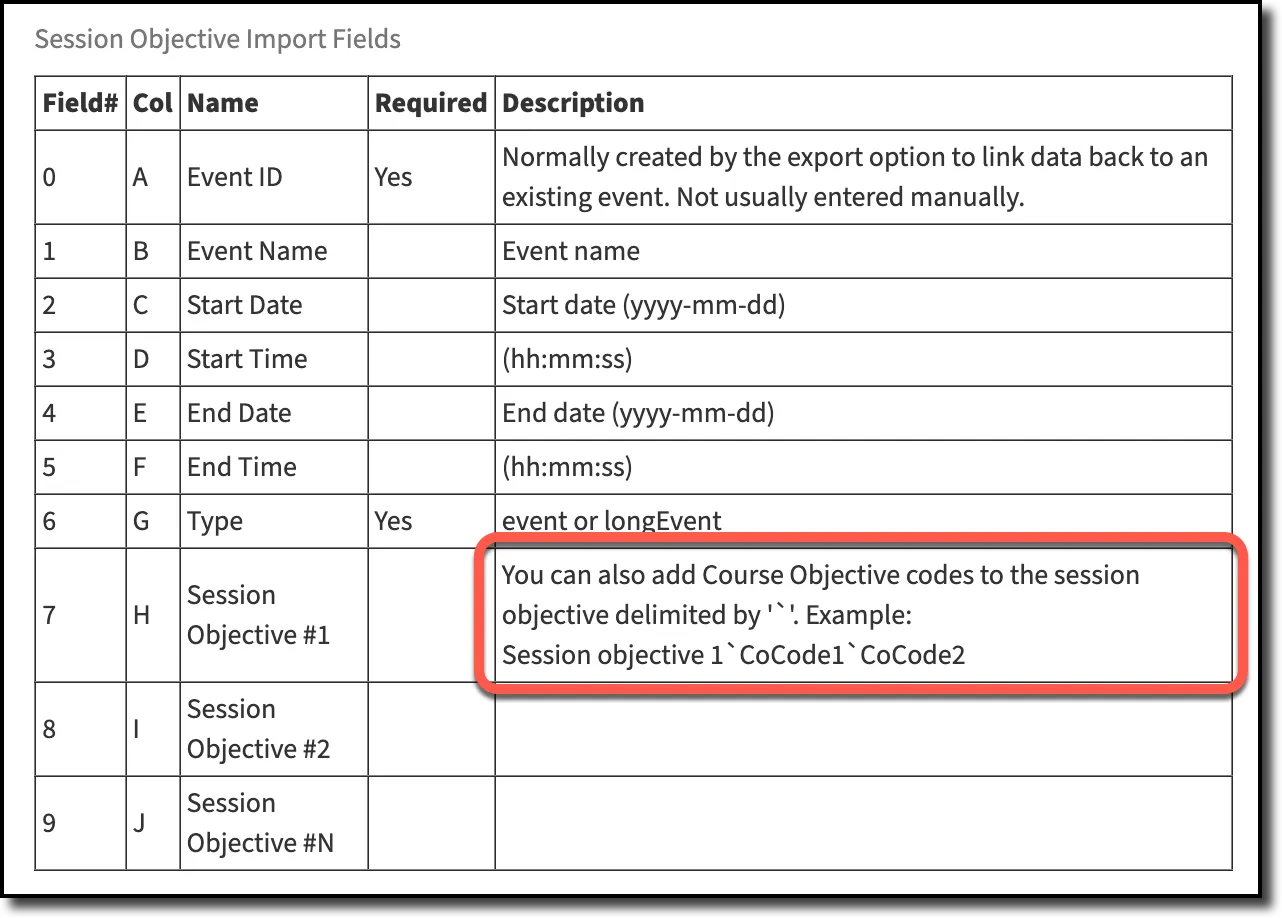
Event imports now use a combination of a backslash and pipe symbol (\|) to delimit session objectives, and it will also use the backtick (`) as a delimiter to map session objectives.

Other fields in these imports have also been adjusted to account for the changes to events. Please reference the import fields and/or download a new template as you prepare to import events and session objectives moving forward.
As always, we're happy to answer questions and appreciate any feedback you might have on this new update. Please contact the DaVinci Helpdesk with any questions or concerns.
2/1/2024
We are excited to announce the initial release of the New Event User Interface in Leo! This update brings enhancements to how Events and Linked Events work in Leo, as well as some important news regarding Long Events and Session Objective Imports. Keep reading below to find out more!
This update is now live in your Preview Environment. We plan to launch this in your Production Environment towards the beginning of March. Stay tuned for more details!
Re-envisioned User Interface

Adding a new event in Leo has never been easier, and you can now create all of your events from a single place! If you don’t want to designate a specific time for an event, just use the “all-day” option. All-day events can span a single day or multiple days, and they will appear at the top of your calendar. Essentially, the “all-day” event option replaces the need to create Long Events separately (more on that below).
We’ve even added options for adding faculty and groups on the same page. This should save you a lot of time when updating events and preparing for new courses in Leo.
Linked Events Makeover
You will also encounter the New Events User Interface when you are creating new Linked Event Templates and adding new Linked Events to your courses. Remember! Outside of the Event Name and Type, all of the settings for a Linked Event Template are optional. Any settings you do adjust on the Linked Event Template will be applied to all of the Linked Events you create.

Additional Details
All of the settings you are used to are still available. Need to update the attendance or attire fields? Just expand “Additional Details” to make those changes and click Save!
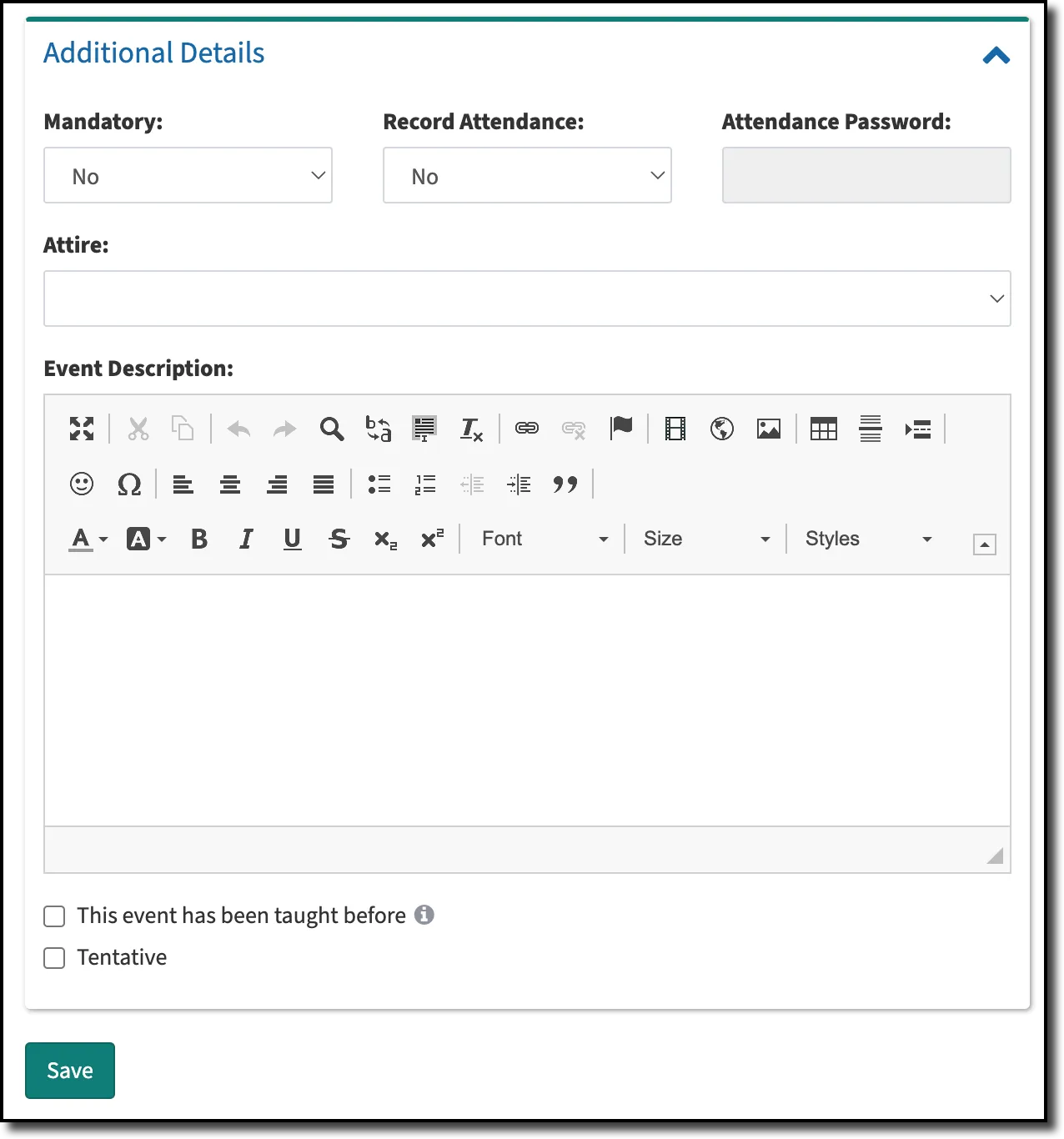
Long Events
As you use the new events interface, you will notice it has much of the functionality and benefits of Long Events. As such, you should be able to use the new events interface for the purposes of creating those same types of events, as we plan to phase out Long Events from Leo.
Timeline
- This summer, we will begin with disabling the creation of Long Events. You will still be able to see and manage them in your system.
- In the Fall, we will begin to migrate and convert all your Long Events data into the new event format, which will work like any other normal event.
- Finally, in the winter of 2024/2025, Long Events will no longer be a feature available in Leo and will be sunset.
We will be in touch over the coming months with more information regarding the eventual sunsetting of Long Events and the conversion process. In the interim, we would highly encourage you to begin taking advantage of the New Events User Interface once it is live in your Production system instead of continuing to utilize Long Events.
Session Objective and Event Imports
As part of this update, we took the opportunity to revise how the session objective import will function moving forward. Currently, a forward slash is used as a delimiter to map session objectives to a course or program objective. Due to the common occurrence of forward slashes in everyday language, we are modifying this import to use a backtick (`) as a delimiter. This key is often found to the left of the number one (1) on a keyboard.
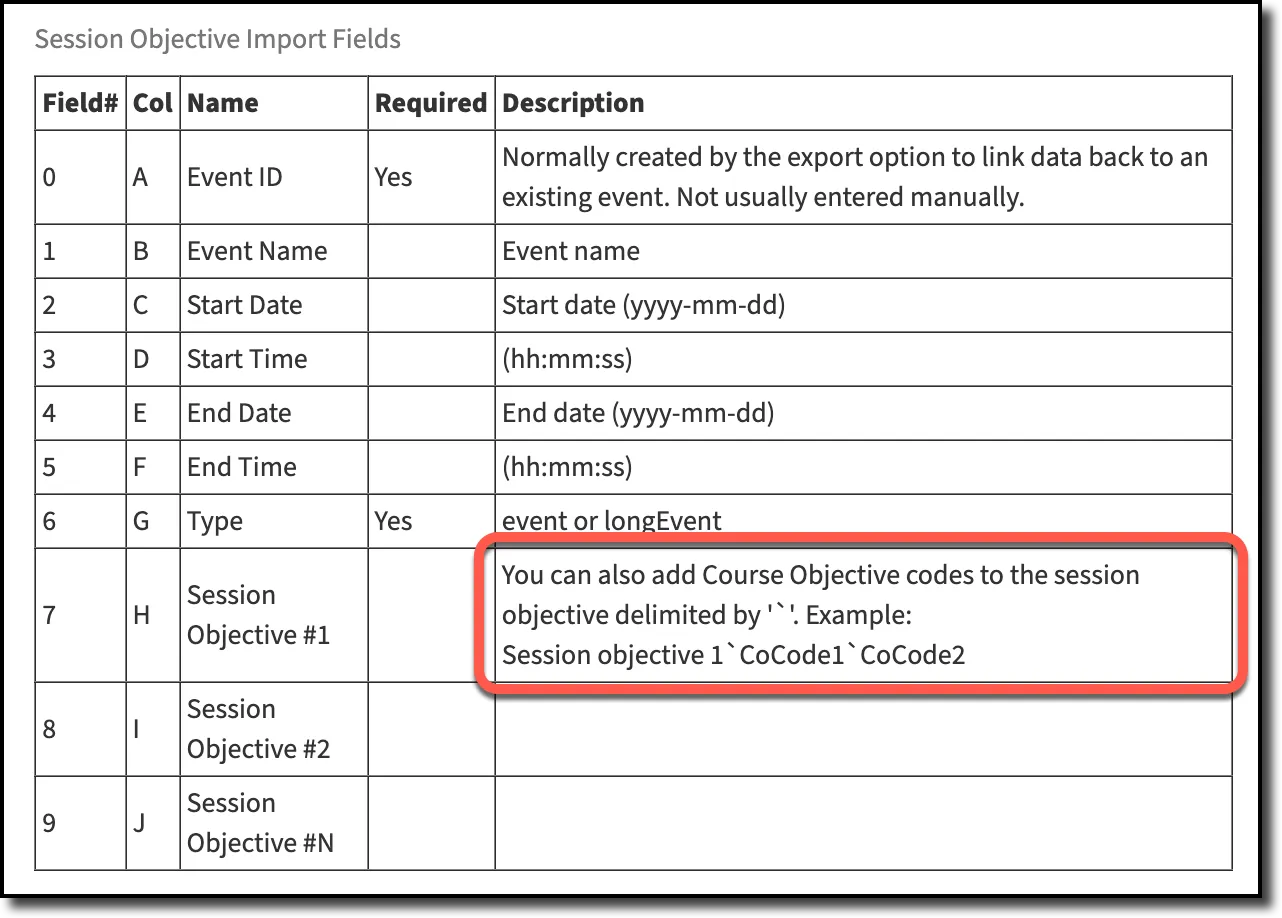
Event imports will use a combination of a backslash and pipe symbol (\|) to delimit session objectives, and it will also use the backtick (`) as a delimiter to map session objectives.

Other fields in these imports have also been adjusted to account for the changes to events. Please reference the import fields and/or download a new template as you prepare to import events and session objectives moving forward.
User Guide Updates
Our team is hard at work updating User Guide articles and those will all go live once this update is released to your Production environment. We will be sure to give you more detailed information about the exact release date in the coming weeks (we anticipate rolling this update out to Production at the beginning of March).
Here’s a quick tutorial on how to add events to Leo using the New Events User Interface. As always, we're happy to answer questions and appreciate any feedback you might have on this new update!

12/20/2023
Before the holiday break, we wanted to let you know about a new addition we’ve made to help manage the new MSPE Assistant in Leo as well as some other features that are coming soon to Leo.
MSPE Course Template Report

The MSPE Course Template is now live in your production system. This report provides a single location that will allow you to keep track of which courses are included in the MSPE Assistant, and which courses are not. From this single screen, you can adjust Course Template gradebook settings, update comparative analysis charts, and see which courses are missing information. Access the MSPE Course Template report by navigating to the Admin Toolbar > Advanced > MSPE Administration > Course Template.
Also, you have the option, with a single click to include, or exclude, a course from the MSPE Assistant. For those not using the MSPE Assistant, you can view the excluded courses and get access to edit Course Template gradebook settings for a given academic year - saving you a lot of time if you need to make updates to Course Template settings throughout Leo.
Coming Soon
MSPE Student Report
We are also working on adding more features to help manage students who are participating in the MSPE Assistant. So, whether managing courses or students in association with the MSPE, you’ll have a place to access data in bulk.
Leo’s New Events User Interface
Early next year, be on the lookout for an update to the user interface for adding and editing events in Leo. Soon you’ll have the capacity to create all-day and multi-day events. This means that Long Events will no longer be needed for managing those events that span multiple days.
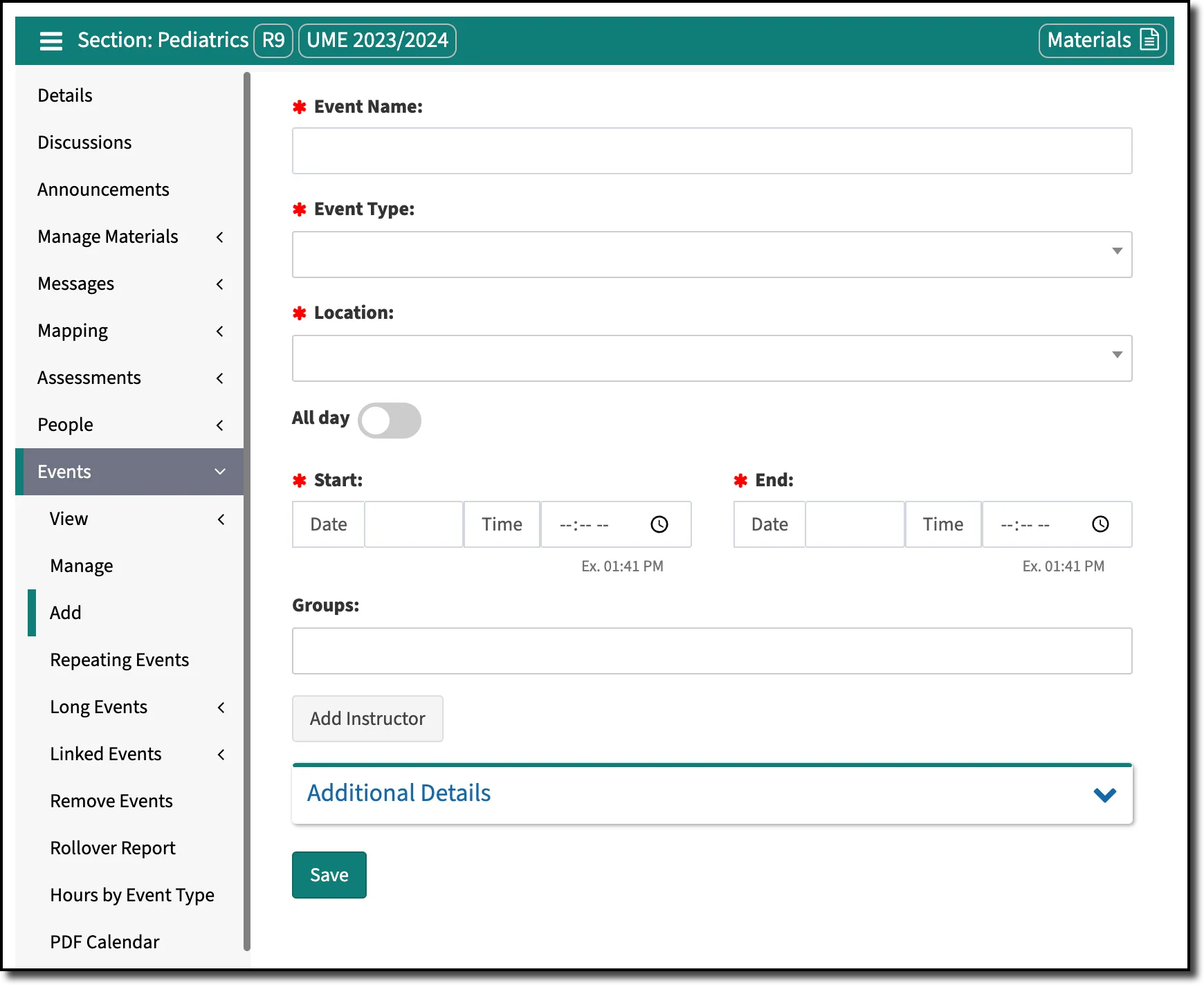
We Want Your Feedback
DaVinci Education is proud to be your partner in healthcare education and we truly value your feedback and suggestions. At this time, we’re actively seeking feedback on the MSPE Assistant and would love for you to complete this short survey. Your experiences will be directly used to refine the features and workflow of the MSPE Assistant.
DaVinci Education Holiday Hours
The holidays are nearly upon us and we wanted to make sure you know when our office will be closed. The Davinci Education offices will be closed from December 21st through January 1st. While we will be on the lookout for urgent issues, we ask for your patience regarding response times for those urgent issues while our team takes time off.
11/27/2023
We are excited to announce that the MSPE Assistant is now live in your Production environments! The MSPE Assistant is designed to ease the burden of collecting data and generating MSPE letters for your students. Once enabled and configured, you will be able to use the MSPE Assistant to organize all the disparate data and information into one location in Leo and export a draft version of the MSPE letter.
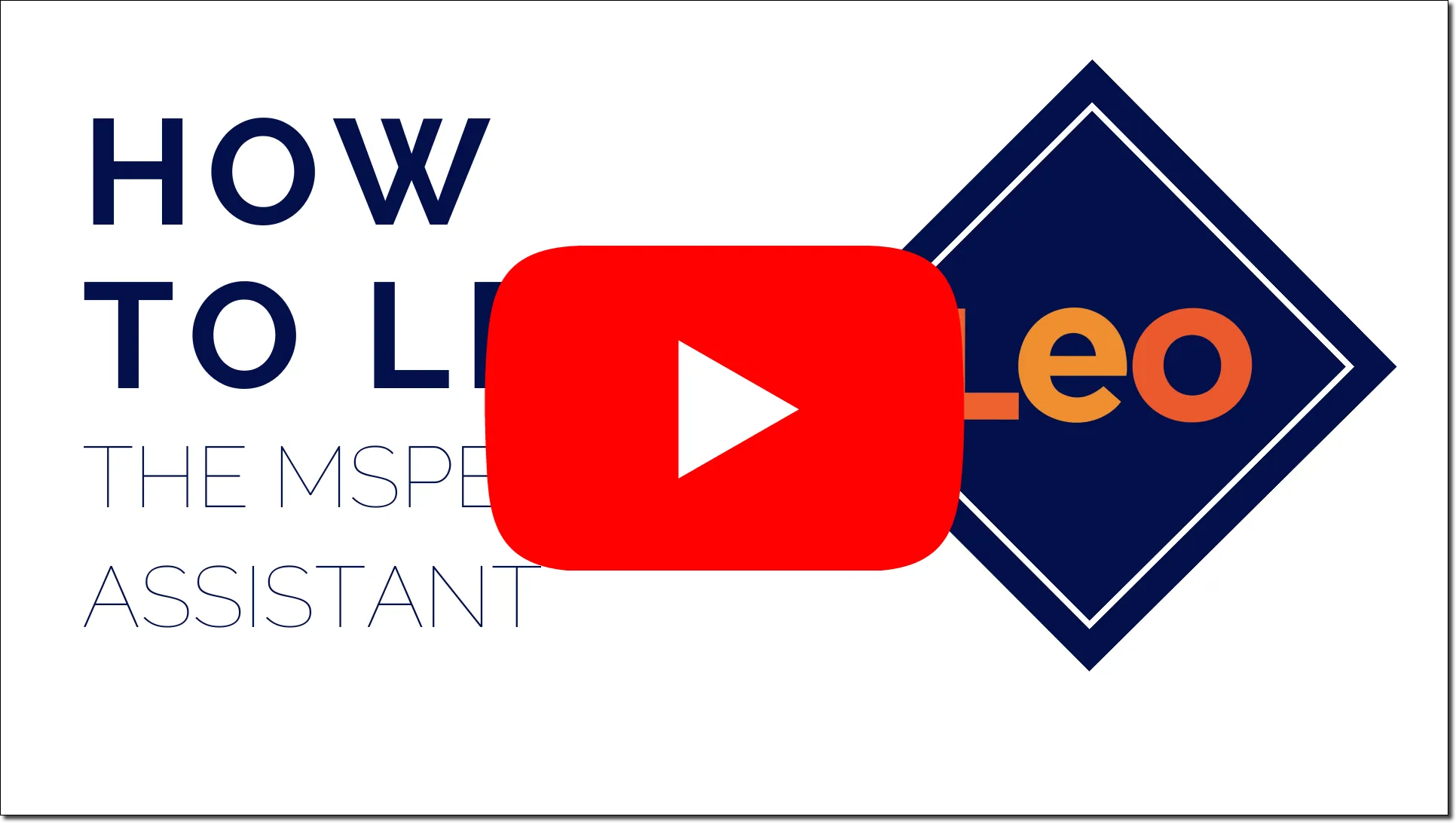
Learn more about how to utilize and take advantage of the MSPE Assistant in Leo by visiting our user guide. We’ve got plenty of tips and tutorials available for you to take advantage of this new tool.
We Want Your Feedback
DaVinci Education is proud to be your partner in healthcare education and we truly value your feedback and suggestions. At this time, we’re actively seeking feedback on the MSPE Assistant and would love for you to complete this short survey. Your experiences will be directly used to refine the features and workflow of the MSPE Assistant.
More Control Over Embed Options
We’ve updated the behavior associated with embedding content in Leo. Previously, when adding embedded content to event or course descriptions, Leo would display that content at 100% width. We’ve updated that process to give you more control over your embedded media. Leo will now respect your embed parameters and style (width and height, e.g.). If you want your iframe to continue to display at 100% width. You can edit the iframe settings in the description by clicking on the iframe and setting the width to “100%”.
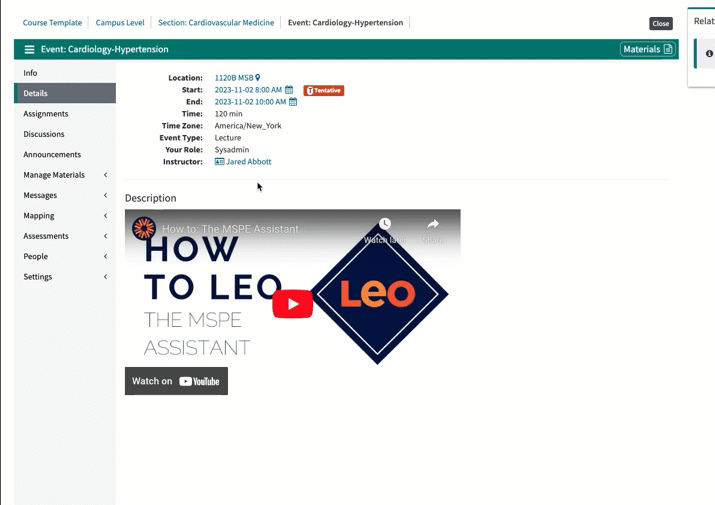
DaVinci Education Holiday Hours
The holidays are quickly approaching and we wanted to let you know ahead of time when our office will be closed. The Davinci Education offices will be closed from December 21st through January 2nd. While we will be on the lookout for urgent issues, we ask for your patience regarding response times for those urgent issues while our team takes time off.
Wishing you and yours a wonderful holiday season!
11/02/2023
We are excited to announce that the MSPE Assistant is now live in your Preview environments! We hope you will take advantage of this Preview period to give us your valuable feedback on the feature, as we prepare to make it available in your production systems on November 15th.
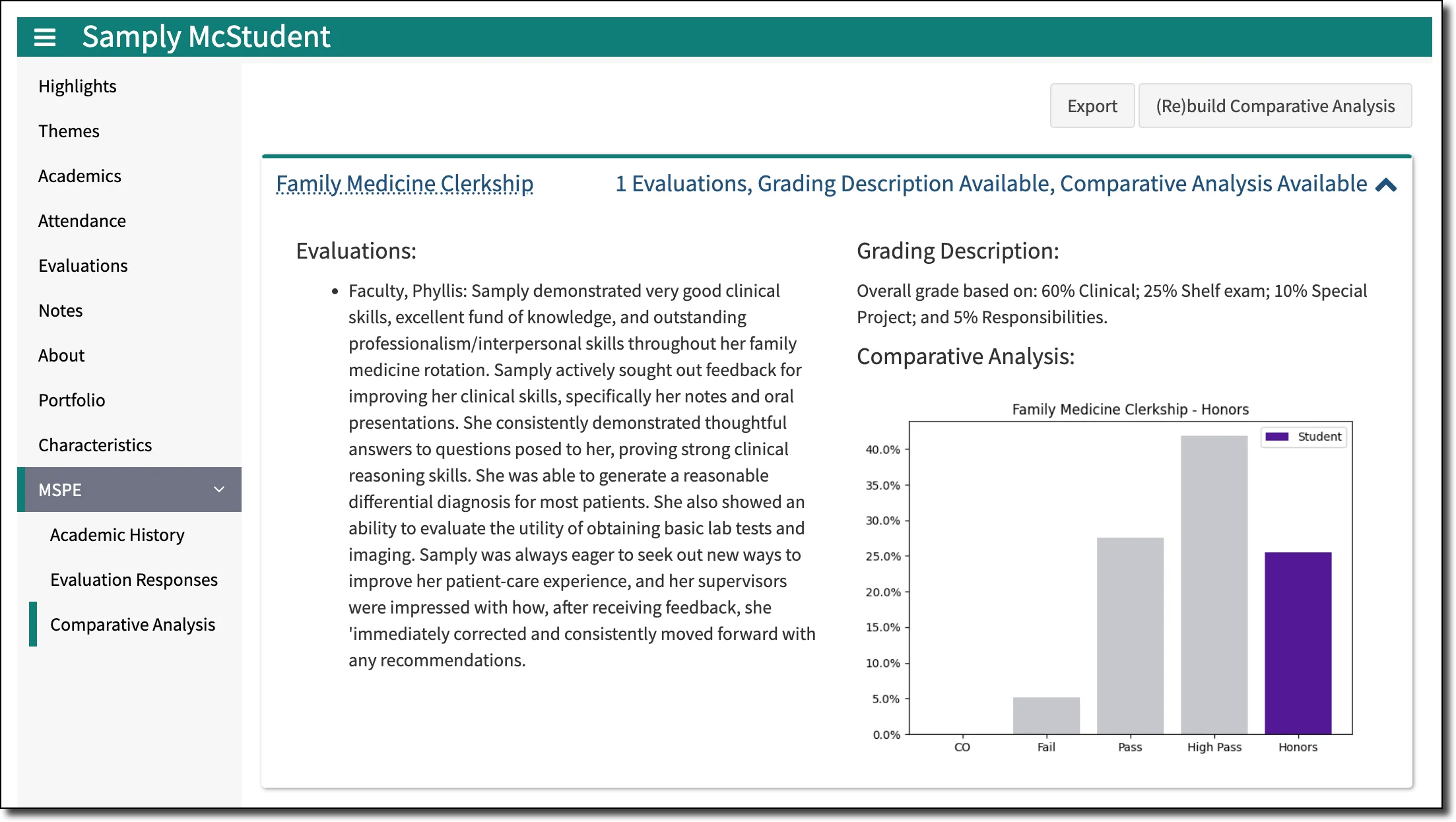
The Comparative Analysis component of the MSPE Assistant in Leo
The MSPE Assistant is designed to ease the burden of collecting data and generating MSPE (Medical Student Performance Evaluation) letters for your students. Once enabled and configured, you can use the MSPE Assistant to organize all the disparate data and information into one location in Leo and export a draft version of the MSPE letter. Some of the benefits of the MSPE Assistant include:
Student Performance Comparative Analysis
Utilize graphical representations to compare each student's performance to their cohort.
Seamless Exports
With one click, export the student’s academic history, narrative comments from student evaluations, noteworthy characteristics, comparative graphs, and academic performance into a Word document for further editing.
Roles & Permissions
Allow your students and their mentors to view all the MSPE content within Leo, or you can choose not to!
Configurations
Select exactly which courses, grade matrices, and evaluations per student to include in the MSPE letter.
Learn More About the MSPE Assistant

Learn more about how to utilize and take advantage of the MSPE Assistant in Leo by visiting our user guide. We’ve got plenty of tips and tutorials available for you to take advantage of this new tool.
We Want Your Feedback
DaVinci Education is proud to be your partner in healthcare education and we truly value your feedback and suggestions. At this time, we’re actively seeking feedback on the MSPE Assistant and would love for you to complete this short survey. Your experiences will be directly used to refine the features and workflow of the MSPE Assistant.
SCOPE Survey Updates
The AAMC/AACOM Curriculum SCOPE Survey, which is replacing the Curriculum Inventory Report, will be launching on November 14, 2023, and will be open for submission until February 6, 2024. Your Curriculum Dean should be receiving communication from the AAMC on November 14, 2023, with details regarding completing the survey.
While Leo may prove useful as your team works to complete various components of this survey, if you are using the AAMC keywords as Themes in Leo (and you are mapping those Themes to events in Leo), the Summary by Events report should prove helpful in answering some of the curriculum content questions listed on the latest draft version of the survey by the AAMC. Access this report by navigating in the Admin Toolbar to Curriculum Mapping > Reports > Themes > Summary By Events.
Please let us know if you have any other questions about the SCOPE survey that you believe Leo can help you to answer. We are here to help!
10/06/2023
I’m thrilled to welcome Edmund O’Neill as our new Chief Product and Technology Officer at DaVinci Education. Stepping into this role, Edmund is charged with helping us develop innovative ways to add meaningful value across the landscape of healthcare education.
Edmund brings over 15 years of EdTech product and technology leadership to our team, having steered key product initiatives for companies such as Liasion International, 2U, and the Relay Graduate School of Education. Developing strategic roadmaps for multiple SIS, LMS and ERP systems has given Edmund a deep and broad understanding of the connections that underpin effective EdTech solutions in higher education. His skills at leading and growing the colleagues around him make him a particularly valuable addition to our leadership team.
For over a decade, DaVinci Education has committed to a vision of helping medical schools and other health science programs streamline operations and increase efficiencies. Now we are preparing to deliver even greater value with comprehensive, actionable data insights and solutions designed to meet your particular needs.
I look forward to working alongside Edmund and the rest of our team to bring you the very best products and services as we support your efforts to educate our next generation of healthcare professionals.
Please feel free to welcome Edmund with a note to edmund.oneill@davinci-ed.com. We look forward to sharing our product plans with you as we continue to grow!
09/27/2023
We wanted to send along a quick note to let you know about some of the latest updates and enhancements to Leo. We are also looking forward to seeing some of you in person at conferences this fall. Read below to find out more!
Bulk Assign Grade Matrices
Many of you are managing many different courses across your curriculum, especially when it comes to the clinical component of your program. We also know that assigning grade matrices for those courses is one of those annual tasks that, while important, can consume a lot of time. Now, you can do that in a single location! Just go to the Admin Toolbar and click on the Assessment tab. Choose Assign Matrices to open up a new report screen with Bulk Action options. Select the courses to which you want to assign matrices (remember you can filter or search for specific courses to make this easier) and choose Assign Grade Matrix from the drop-down. Now you can select any Grade Matrix in your system.
This update is already live in your production system!

Assignment Flags
Keeping track of assignments is vital for students to stay on top of a fast-paced health sciences curriculum. To aid students in the process, we are adding a visual indicator to the Leo Calendar. Much like the flags for mandatory events and events with a dress code. Events with assignments will now show an ‘A’ on the Leo Calendar. We are also adding this visual indicator along with the assignment due date to the event details hover on the Leo Calendar.
This update will be live in your preview environments this week, and we expect to push out this update to your production environments in the coming weeks.

SCOPE Survey Updates
The AAMC has announced that the replacement for the Curriculum Inventory Report (CI), the SCOPE Survey will launch on November 14, 2023. They will be using a survey tool called Verint to collect the data. Our team is reviewing the final draft of the survey and will be offering guidance on how Leo can help aid in the completion of various components of the SCOPE Survey. Be on the lookout for more information from DaVinci and the AAMC as the launch date approaches.
Fall Conferences
We are looking forward to seeing some of you at this year’s ChangeMedEd® conference in Chicago this week!
We’ll also be in Seattle in early November at the AAMC annual meeting, Learn Serve Lead. We are excited to visit with you all at these wonderful events. Stop by our booth at each of these upcoming conferences and say hello!

If you have any questions please reach out to our help desk. Have a great week!
07/20/2023
Many of you joined us last month for The 2023 Leo User Conference. It was an exciting two days full of announcements and learning from the Leo User Community and members of the DaVinci team. We wanted to offer a recap of that event. Let us know if you have any questions about these updates or what’s coming soon!
MSPE Assistant
Announced during the Leo User Conference, we will soon be introducing a brand new feature to Leo, the MSPE Assistant. This new tool will allow schools to generate MSPE (Medical Student Performance Evaluation) templates for their students using the necessary data that already exists right inside Leo! Be on the lookout for this new feature coming soon as well as in-depth tutorials for how to get started using this tool to speed up the process of generating MSPE letters for medical students..
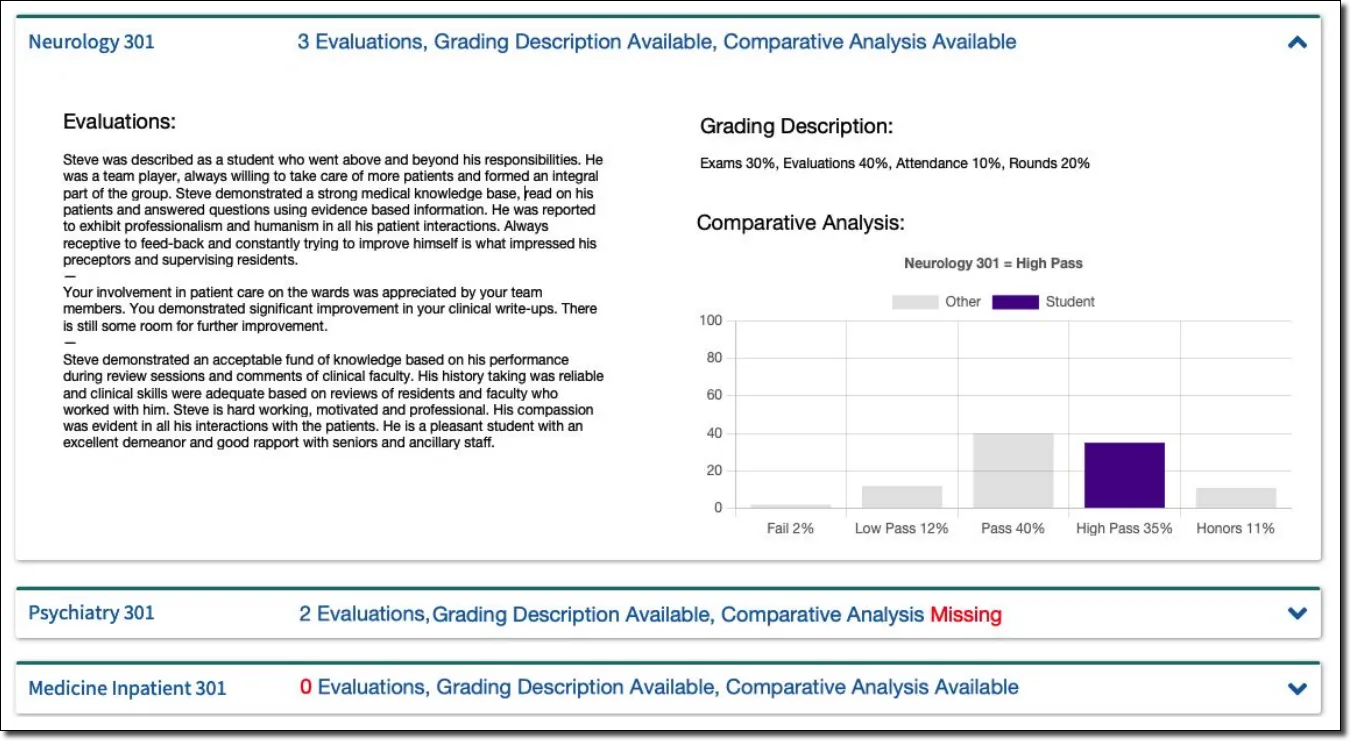
New Events User Interface
This new update was introduced at The Leo User Conference and will make creating and managing events in Leo easier than ever. Once released, you will no longer need Long Events* in Leo. You’ll be able to create events from a single location. Those events could last an hour or multiple days. You’ll also have the ability to flag events as “all-day” events. As part of this update, the “Add Event” user interface is getting a makeover. So, it will be easier to use, more accessible, and will work better on mobile devices. Stay tuned for future updates to learn how you can take advantage of these new features for events.
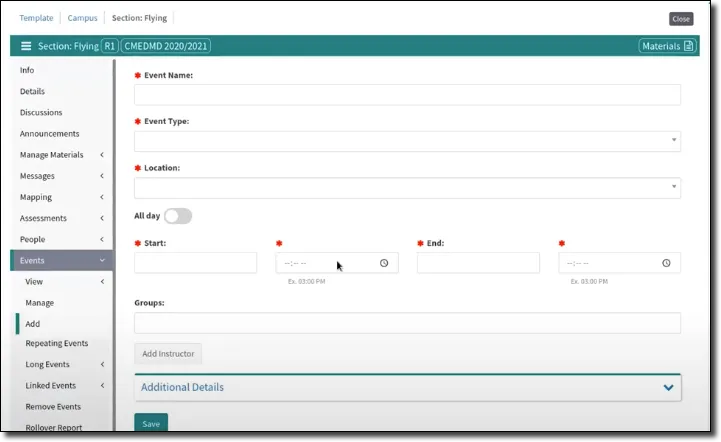
*Long Events will still exist in Leo, for now, but we have plans to eventually convert them to the new events user interface and phase them out over the next year.
LTI User Interface Update
As part of our ongoing efforts to bring new capabilities to Leo, we have re-engineered the way LTI works in Leo. This brings an updated user interface for creating LTI connections, and we have ongoing development to take it beyond existing capabilities by making it compliant with LTI 1.3. This will allow you to integrate with a variety of tools to accomplish all your teaching and learning goals with Leo! Once released, we’ll be providing updated user guide articles and information about how to utilize the new user interface to connect to LTI content in Leo. We’ll also be sure to keep you updated on our progress as we continue to work towards making Leo LTI 1.3 compliant.

Recent Updates
We also wanted to mention a few updates that have been installed recently and are live in your production system. Read below for more information.
Calendar Time Zone Update
Now, when a user is viewing the calendar in “day view” it will show events in the user’s timezone if it differs from the timezone selected in the user’s profile.
On-Demand Evaluation Settings
There are now two additional settings in the Account Manager (Admin Toolbar > Advanced > Account Manager > Modules > [Program] General Evaluation Settings) that affect the behavior of on-demand evaluations.
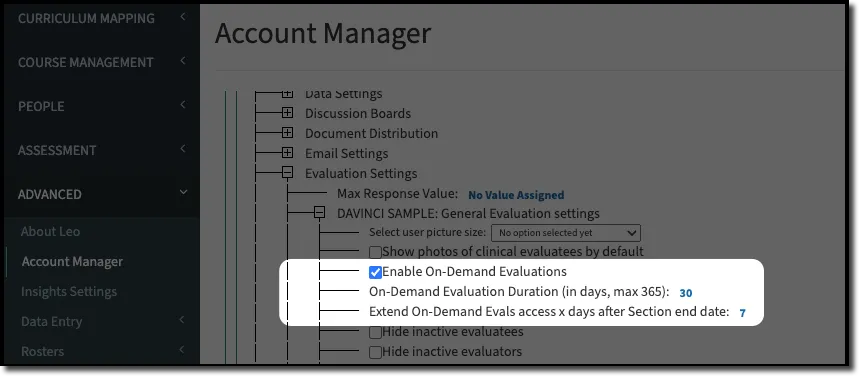
Extend the default duration of On-Demand Evals
You can determine how long an evaluator will have to complete an on-demand evaluation. If no value is assigned to this setting, Leo will use the default duration of 14 days.
Extend access to On-Demand Evals
You can also now determine how long users can request or initiate on-demand evaluations after the end of the course. By default, Leo will not allow students or faculty to request new evaluations once the course has ended. Adjusting this setting will allow you to extend that time for your program.
If you have any questions please reach out to our help desk. Have a great week
06/15/2023
We have a couple of new updates to Leo that we wanted to share with you. These are now live in your Production System. Read below for more details and contact the help desk if you have any questions!
Gradebook / Academic Portrait Enhancements
We’re continuing to improve Gradebook and Academic Portrait functionality. Alpha scores now appear in the Academic Portrait even if there is no numeric score in the Gradebook. The Gradebook and Academic Portrait also both show percentage scores up to two decimals. While students will only see the “visible” grade in each course, depending on which categories and assignments have been released, Faculty Mentors will continue to have access to all course grades for a student regardless of the release state. We have added a notice to remind Faculty Mentors of their higher level of access.
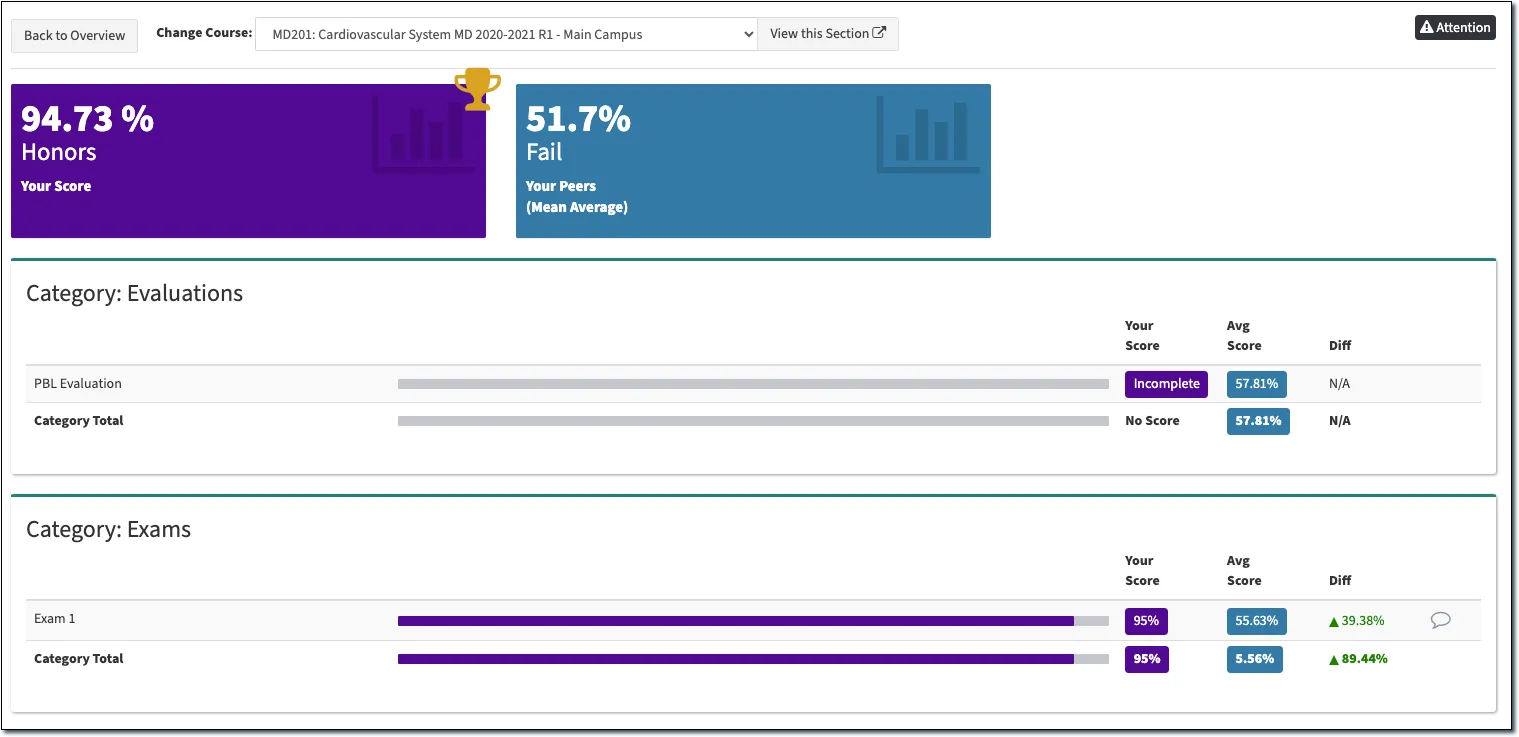

On Demand Evaluation Due Dates
We have added a new setting so that On Demand Evaluations can still be requested even if the course is over. We’ve also updated the experience to make requesting evals even easier. When an Evaluation on a course needs to be requested, the course drop-down is now arranged to show active courses first, followed by past courses that have ended. In your Account Manager settings [Admin Toolbar > Advanced > Account Manager > Modules > Evaluation Settings > (Program) General Evaluation Settings > Extend On-Demand Evals access x days after Section end date], you can designate how many days after the end of a course individuals will be able to request an On-Demand Evaluation. This setting will apply to all on-demand evaluations for a specific program. The default will remain 14 days if not modified.

The Leo User Conference is next week!
The 2023 Leo User Conference is one week away! We are excited to share with you some exciting new features and enhancements coming soon to Leo. We are also really looking forward to hearing from members of the Leo User Community as they share information about curriculum mapping, clerkships, and other ways they are using to gain efficiencies and insights! The Leo User Conference will take place on June 21-22, 2023, and will happen virtually. Click here to learn more and register for this year’s event.
If you have any questions about these updates or the Leo User Conference, please reach out to our help desk. Have a great week!
06/14/2023
I know many of you participated in the recent call with the AAMC around the planned changes to the Curriculum Inventory (CI) reporting project. We also joined a vendor call with the AAMC on that topic, and I wanted to offer you a quick update from our perspective.
On our call with the AAMC, we heard a basic explanation of some of the planned changes. Multiple vendors asked for specific parameters and examples that would help us explain these changes to our clients. But the AAMC team made it clear that their process is still under construction. Unfortunately, the plans are not yet concrete enough for us to be able to make any determinations about the next steps you’ll need to take in regards to reporting your curriculum to the AAMC.
We have been informed that another vendor meeting will happen in July, and we’re hopeful that we will receive more clarity and specifics at that time around what the AAMC is expecting from member schools. As soon as we know more, we will share our thoughts on how you can leverage Leo to participate in this new initiative from the AAMC.
Meanwhile, I’m confident you can still find considerable value from your curriculum mapping in Leo as you use it to make your own internal assessments of your curriculum. The DaVinci Education team has taken great care to build the curriculum mapping structure in Leo in a way that can deliver value independent of any external reporting requirements.
Our goal is always to deliver solutions that will help make your jobs easier. We will continue to actively engage with the AAMC and share any new insights with you as soon as we have them.
In the meantime, please let me know if you have additional questions. And please accept my personal gratitude for your ongoing partnership.
06/01/2023
We have a few updates to share with you! These changes are now live in your Production Environment. Please read below for an overview of recent improvements/changes, and let us know if you have any questions.
Leo Course Objectives Import
Previously, the course objective import prevented course objectives from being imported when the ‘Course Objective Code’ field exceeded the 10-character limit. The character limit is still in place, but now you will see an error message if the .csv file you are attempting to import contains a Course Objective Code that exceeds 10 characters.
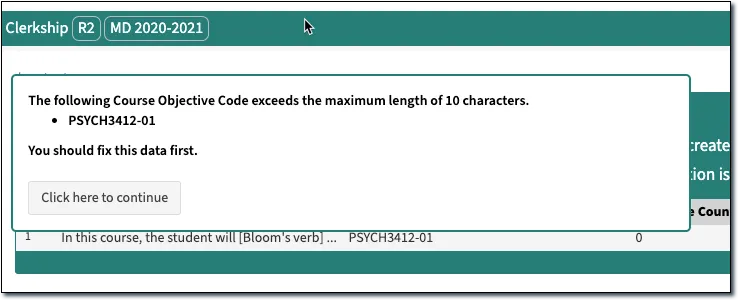
Roster Reports with Course End Dates
We made some updates to the Registrar History (enrollment) report to show course end dates for all students and courses regardless of how they were enrolled in a course section. This report can be found by navigating to Admin Toolbar > People > User Management > [select a student] > [choose 'Roster'].
Pushing Exam Scores to the Gradebook
We made additional updates to how exam scores are pushed to the Gradebook. Now, if you edit an exam, re-evaluate the responses, and send scores to the Gradebook, Leo will update the “Max Score” in the Gradebook to reflect those changes. You will no longer need to manually change the Score in the Gradebook assignment settings.
Help Desk Update
The DaVinci Team will be at a company retreat from Tuesday, June 6th - Wednesday, June 7th. Our Help Desk response time may be delayed as a result. If an urgent matter arises, please include “Urgent”' in the title and detailed information regarding the issue, and our team will be sure to get back to you as soon as possible.
The Leo User Conference is just around the corner!
The 2023 Leo User Conference is less than one month away! During this two-day event, we’ll focus on all the changes we’ve made over the last year and share some exciting changes you can expect to see in Leo soon. We’ll also have members of the Leo Community participating in another Clerkship Panel discussion, as well as another rendition of the Leo Community Showcase! The Leo User Conference will be June 21-22, 2023, and will happen virtually. Click here to learn more and register for this year’s event.

If you have any questions about these updates or the Leo User Conference, please reach out to our help desk. Have a great week!
05/13/2023
We want to share a few updates with you! These changes are now live in your production environment. Please read further for an overview of the updates and let us know if you have any questions.
On-Demand Evaluations Access
We've made some changes to on-demand configurations. Courses that have ended will no longer be included in the available on-demand evaluation selection. This should help to “clean up” the dropdown list for students who have gone through multiple courses that have on-demand evaluations configured. Learn more about creating on-demand evaluations in Leo.
Small group Enrollment during Course Rollover
Small groups will now automatically roll over when you perform a course rollover, making your mapping and event assignment easier. Previously, only the small group sets rolled over. Now, you will see the small groups associated with each set roll over as well.
Updated language in Course Rollover options
We've updated the language on the course rollover screen for Course Materials. This language clarifies that the materials related to the section level of the course being rolled over will also rollover and be associated with the new course.

Exam Responses Report to View Scores Only
We've added a new report option that allows you to view only the students' scores on each exam question, even if they are free text responses. When you open up the Exam Results report, you will now see an option at the top for "All Responses - Score Only", selecting this option will result in allowing you to see just the scores.
This report can be found by navigating to a Course Section > Assessments > Exams > Manage Exams > [click on response column] > Options > All Responses > All Responses - Score Only.
Are You Registered for The 2023 Leo User Conference?
We are super excited to join you at The 2023 Leo User Conference. This year we’ll be focusing on all the changes we’ve made over the last year, as well as sharing some exciting changes you can expect to see in Leo in the near future. We’ll also have members of the Leo Community participating in different sessions and sharing as a part of the Leo Community Showcase! The Leo User Conference will be June 21-22, 2023, and will happen virtually. Click here to learn more and register for this year’s event.
04/03/2023
Last week we mentioned that there were some updates coming to Evals and Search features in Leo. Those changes are now live in your production environment 4/3/23! Please read further for an overview of those changes. Let us know if you have any questions!
Updated Evaluation Response Options
In an effort to clarify how various evaluation responses would be treated when summarized on reports or in summary evaluations, we’ve made some changes to how “N/A” evaluation responses work in Leo.
“N/A” responses are often utilized as an evaluation response option to indicate that the evaluator does not have any knowledge of, or did not observe, how the target (student, faculty, course, etc.) should be rated given the context of the evaluation question. We see this most commonly used in clinical evaluations where a preceptor may not have observed a specific procedure, or the evaluation question does not apply to the patient encounter that was observed.
Previously, to add a “N/A” response to an evaluation question, you would select an option in the question settings dialog screen. However, to allow users more flexibility to customize the text of the “N/A” response (e.g. instead of ‘N/A’ you could enter ‘does not apply’), we have moved this option to the response settings dialog screen. Now, users can indicate which response, if any, they want to be considered a “N/A” response. To further clarify this functionality, responses marked as an “N/A” response will not have the option to enter a value. Leo will allow you to add a single “N/A” response to any question, but no more than one per question.

Any questions that have the option enabled currently in the questions settings will not be affected. The auto-generated “N/A” response will still be available, but you will now have the ability to edit the response as you would any other.
For Rubric questions, the “N/A” response will now be presented to the user in the form of a checkbox that they can choose instead of selecting the “Add Rating” option to select a response. This checkbox will only show up if there is a response designated as “N/A” for that rubric question.

We’ve also made some changes to checkbox questions. You will no longer have an option to enter a value for responses to checkbox questions, as those questions are not included in scoring. For more information please reference our updated user guide article on evaluation questions and response settings.
New Search Functionality
We’ve also added an option on the ‘Search” tab in Leo to allow users to designate whether their search results should match all of the search terms or any of the search terms listed. For example, if you entered ‘heart lungs’ into the search box and selected the “all” option, then you would get fewer results than if you selected the “any” option. We’ve also added this update to our user guide articles on utilizing the search function in Leo.

If you have any questions about these updates, please reach out to our help desk.
03/29/2023
We have a few items we would like to share with you all regarding some updates to Leo. These changes are now live in your preview environment and will be released to your production environment next week. Let us know if you have any questions!
Updated Evaluation Response Options
In an effort to clarify how various evaluation responses would be treated when summarized on reports or in summary evaluations, we’ve made some changes to how “N/A” evaluation responses will work in Leo moving forward.
“N/A” responses are often utilized as an evaluation response option to indicate that the evaluator does not have any knowledge of, or did not observe, how the target (student, faculty, course, etc.) should be rated given the context of the evaluation question. We see this most commonly used in clinical evaluations where a preceptor may not have observed a specific procedure, or the evaluation question doesn’t apply to the patient encounter that was observed.
Previously, to add a “N/A” response to an evaluation question, you would select an option in the question settings dialog screen. However, to allow users more flexibility to customize the text of the “N/A” response (e.g. instead of ‘N/A’ you could enter ‘does not apply’), we are moving this option to the response settings dialog screen. Now, users will be able to indicate which response, if any, they want to be considered a “N/A” response. To further clarify this functionality, responses marked as an “N/A” response will not have the option to enter a value. Leo will allow you to add a single “N/A” response to any question, but no more than one per question.
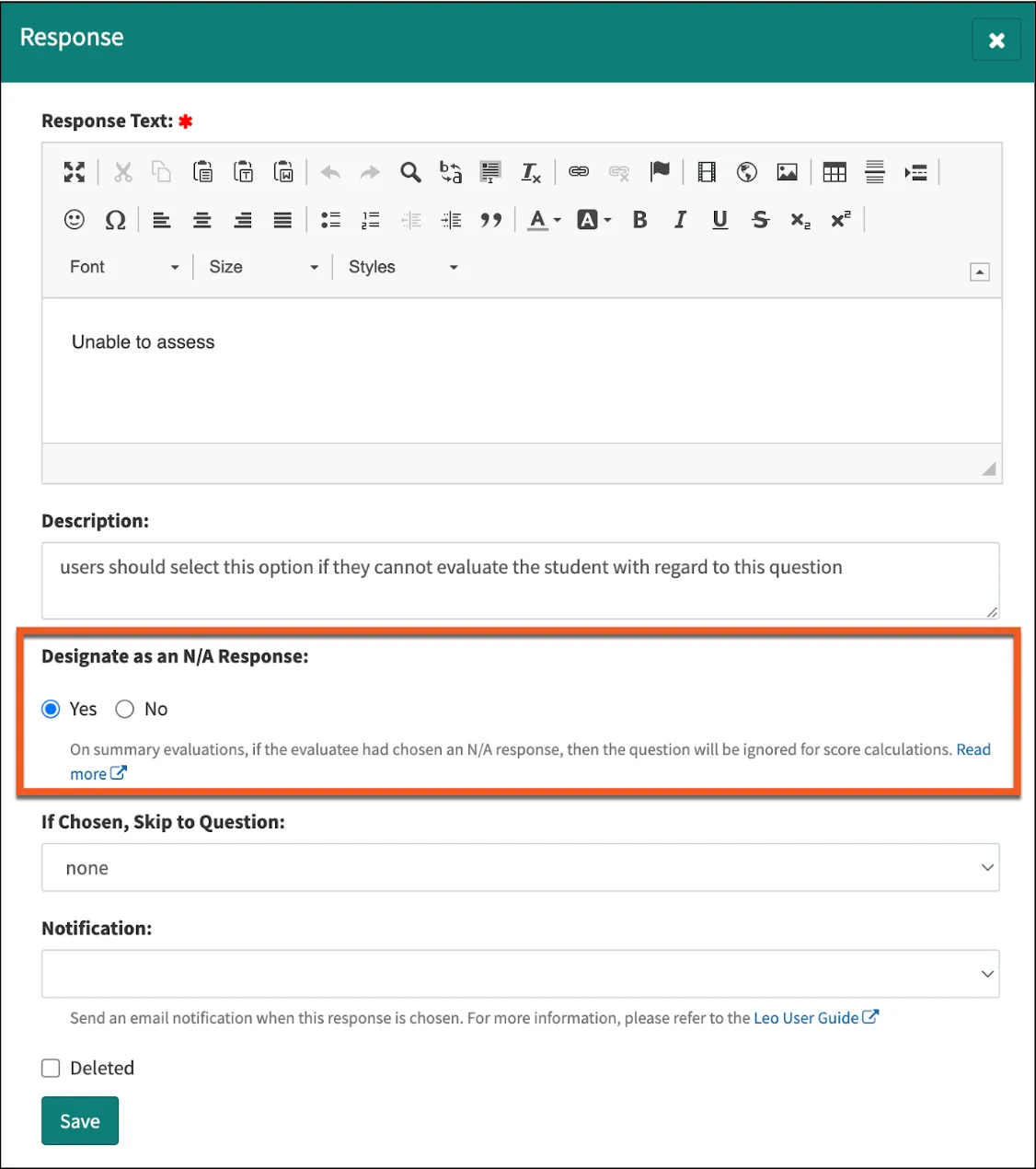
Any questions that have the option enabled currently in the questions settings will not be affected. The auto-generated “N/A” response will still be available, but you will now have the ability to edit the response as you would any other. We’ve also made some changes to checkbox questions. You will no longer have an option to enter a value for those questions, as those questions are not included in scoring. For more information please reference our updated user guide article on evaluation question and response settings.
New Search Functionality
We’ve also added an option on the ‘Search” tab in Leo to allow users to designate whether their search results should match all of the search terms or any of the search terms listed. For example, if you entered ‘heart lungs’ into the search box and selected the “all” option, then you would get fewer results than if you selected the “any” option. We’ve also added this update to our user guide articles on utilizing the search function in Leo.

If you have any questions about these updates, please reach out to our help desk. Remember, these updates are already live in your preview environment and will be pushed out to your production environment next week.
Leo User Conference
We hope you saw the previous announcement earlier this month about The Leo User Conference coming June 21-22. Use this link to register and save your spot for an exciting two days of learning all about Leo!
02/22/2023
We have a few items we would like to share with you all regarding some updates to Leo. These changes should now be live in your production environment. Let us know if you have any questions!
Evaluation Titles Now Appear in Email Reminders
The setting in your Account Manager (Modules > Evaluations > (Program) General Evaluation Settings) > Use EvalLink “Title" rather than Eval Name for display in EWF and Gradebook will now also apply to email evaluation reminders. If this setting in your account manager is enabled, Evaluation reminder emails will include the “Title” assigned to the Evaluation Link when it is created.

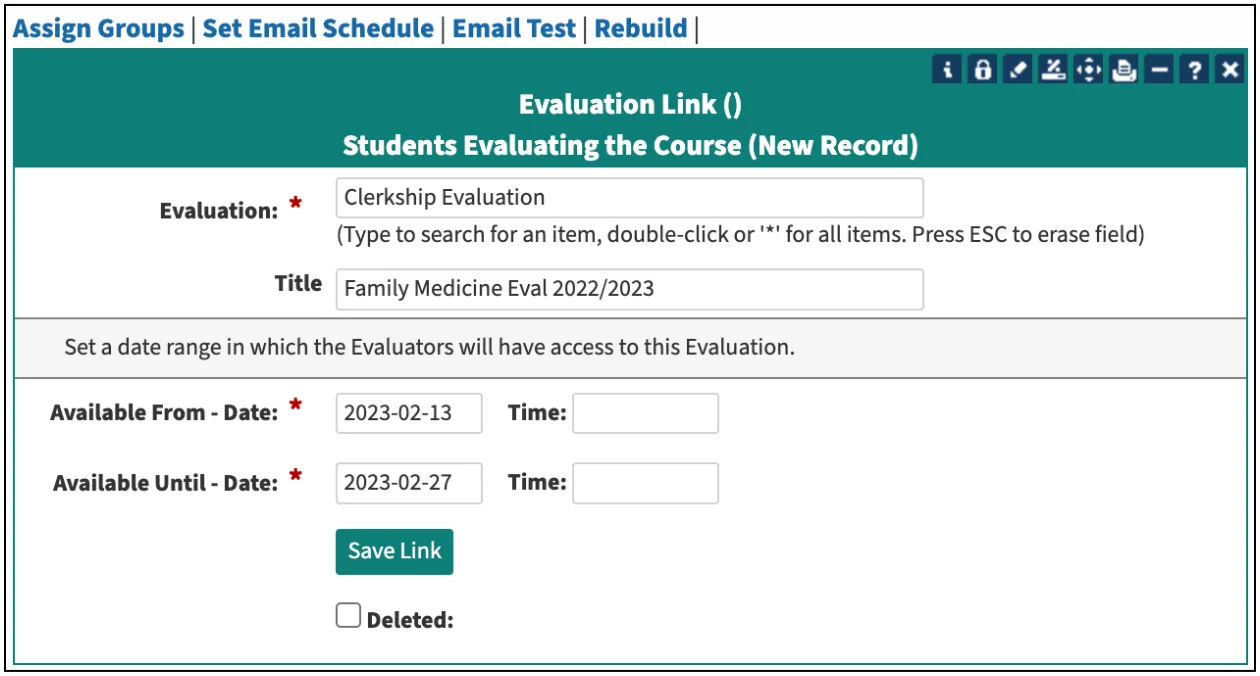
Image Size Increased for Evaluations
The size of the image on evaluations has been increased and should be easier for those completing evaluations of others (students or faculty) to see.
Updates to Absence Request Reports
Previously, the absence requests reports in Leo only showed absence requests that were submitted for events on the current date or later. We’ve made a couple of small changes that should make processing absence requests a bit easier.
The Absence Request report on the Admin Toolbar (People > Absence Requests) will now default to show you all “open” absence requests for the current academic year (not just for today and beyond). You can, though, still use the filter options to view absence requests that have been processed, or change the dates for the requests you need to see.
At the course section level, the absence requests report (People > Students > Attendance Reports > Options > Requests) will also show all requests that are “open” for the current course. These changes should enable attendance administrators to see and process attendance requests more efficiently.
Lottery Update
Each Lottery record in Leo can now only be Run (or Previewed) once the Lottery is no longer accessible to students. You may notice when creating a new Lottery record, the “Run/Preview” button is not accessible. In order to run a lottery, the “End Date” and “End Time” must be in the past.
Leo User Conference
We hope you saw the previous announcement earlier this month about The Leo User Conference coming June 21-22, later this year. We hope you’ll join us for this year’s virtual event! Be on the lookout for more information, as well as a link to register soon.
01/26/2023
We hope the new year and the new semester are both off to a wonderful start for you! We wanted to send a quick update to let you know about some new features and enhancements in Leo - all of which are already live in your production system!
View Course Objectives Across Courses in Leo
With the addition of Course Objectives this past summer, Leo provides a flexible platform for your Curriculum Mapping needs. Now that Course Objectives have a home in Leo, we know that you need a place to see how those Objectives are being utilized within courses. We’ve added the Course Objectives report to provide just that - a holistic view of Course Objectives within your curriculum.
You’ll find this new report by navigating to the Admin Toolbar > Curriculum Mapping > Reports > Course Objectives. This report also includes some new filter options that allow you to get the data you need, when you need it. You can use the search box to further refine the report to include records containing specific keywords.
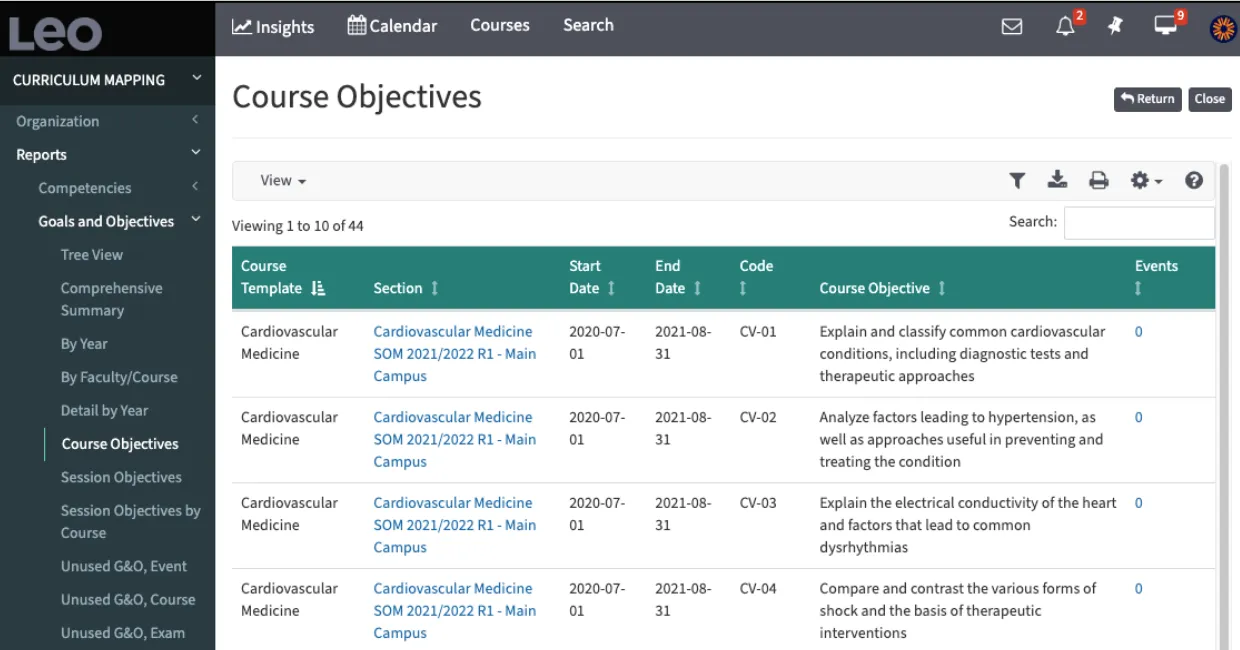
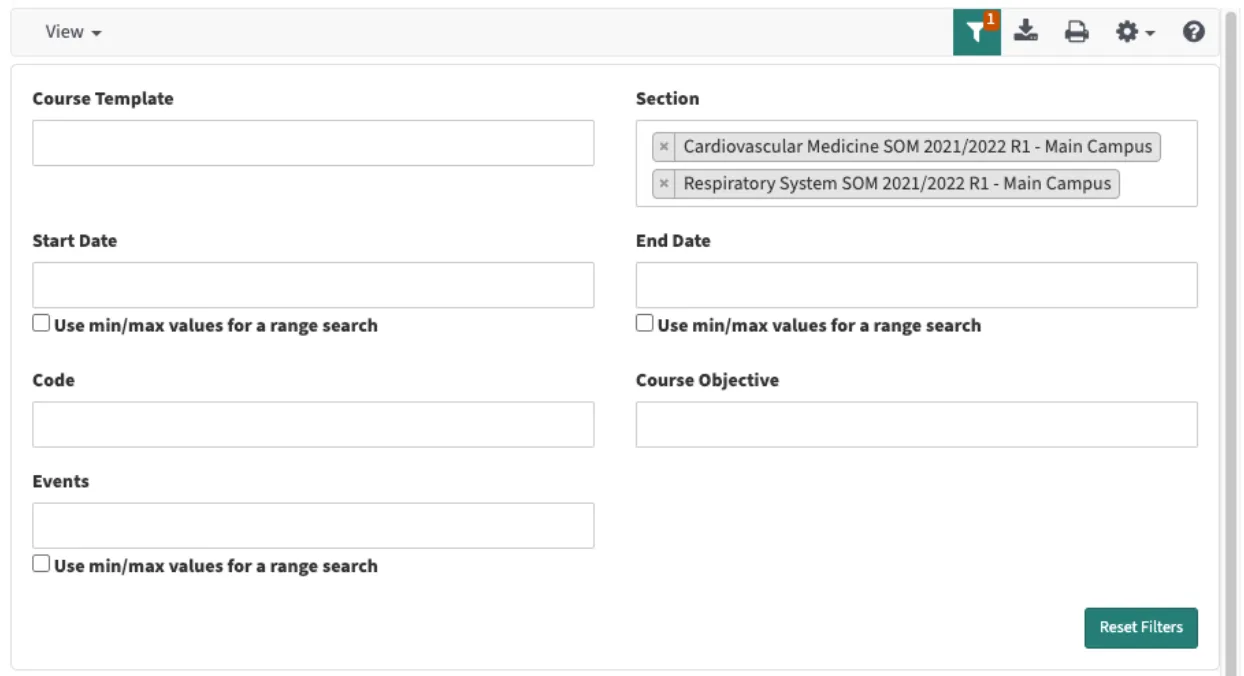
New Option to View Assignment Instructions
Previously, instructions for assignments in Leo were only visible to students, staff, or faculty when they hovered over specific assignment names. We’ve added a new option that will allow users to view any specific instructions for assignments within Events or Long Events. These instructions will appear in a modal window when the user clicks on the “View” link in the assignment report when accessing Event or Long Event assignments or when accessing assignments from the Activity Bell.

Changes to the PET Encounter Log for Course Sections
Previously, the PET (Patient Encounter Tracking) encounter log listed every diagnosis and procedure logged by students in separate rows. This report has been updated so that each actual patient encounter is listed as a single record, with the diagnoses and procedures showing up as columns within the report. Access this report by going to any PET enabled Course Section > Assessments > PET > Encounter Log.

Please contact the DaVinci Helpdesk if you have any questions about these or any other features in Leo.
12/19/2022
New features are now live in your Leo Production system! Save time when creating and assigning evaluations through our new bulk eval tools and more efficiently communicate information about grades to the Academic Portrait with the new automatic release function.
Create & Manage Evaluations Across Multiple Sections
This new feature allows you to more efficiently assign clinical evaluations across multiple sections (or rotations) of a course by eliminating the need to go into each section. We have also released a new report where you can see all of the evaluations that have been created in bulk, assign evals involving clinical faculty to specific individuals, and review student and faculty progress in completing their evaluations. Read more about this process in our user guide.
Auto-Release for Grades
Grades can now be automatically released to the Academic Portrait. This option can be enabled on a course-by-course basis and will still honor your ability to release (or hide) student grades. For more information, check out this User Guide article.
Reset Completed Evaluations
We’ve also added the ability to reset “completed” evaluation summaries. This means that even if evaluation scores have already been pushed to the course gradebook, you’ll still be able to reset and adjust evaluation summaries (e.g., to include evaluations submitted late).
Holiday Hours
The DaVinci Education offices will be closed from December 23 through January 2nd. While we will be on the lookout for urgent issues, we ask for your patience regarding response times for those urgent issues while our team takes time off.
12/15/2022
New features will be live in your Leo Production system this weekend! Save time when creating and assigning evaluations through our new bulk eval tools and more efficiently communicate information about grades with the new automatic release function for sending grades to the Academic Portrait.
Create & Manage Evaluations Across Multiple Sections
This new feature allows you to more efficiently assign clinical evaluations across multiple sections (or rotations) of a course by eliminating the need to go into each section. From the Course Template, choose Assessments. From here, click on Create Bulk Evaluations. Select the type of evaluation, choose the form you want to use, enter a title (optional), and follow the prompts to assign evaluations to the chosen sections of the course. Then hit create - the evaluations will now be in each of the sections you selected!
To manage any evaluations that are created via this new tool, click on Manage Evaluations in the Course Template menu. From this report you can see all of the evaluations that have been created in bulk, assign evals involving clinical faculty to specific individuals, and review student and faculty progress in completing their evaluations. Read more about this process in our user guide.
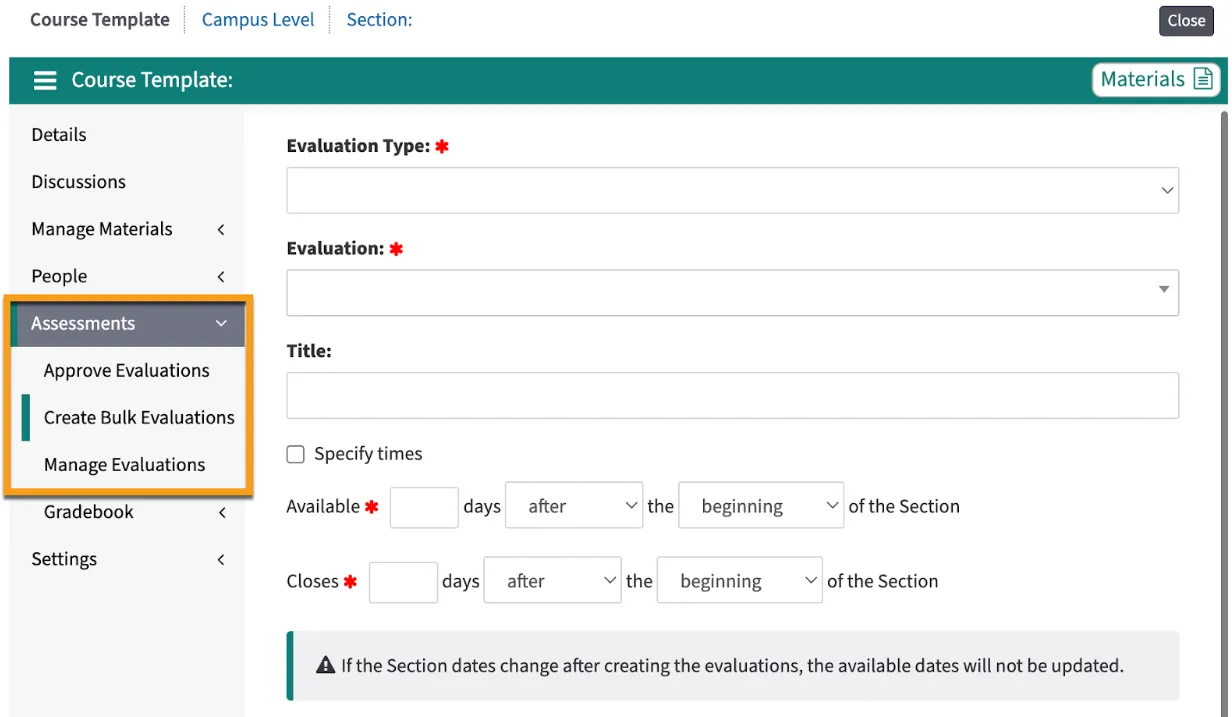
Auto-Release for Grades
Now, when you update grades within a course section in Leo, those grades will automatically show up in the Academic Portrait. There is no longer a need to create a snapshot of the gradebook every time you want the scores to update. Now students will always see the same scores, assignments, comments, etc. in the course section and in the Academic Portrait. This option can be enabled on a course-by-course basis and will still honor your ability to release (or hide) student grades.
Holiday Hours
The DaVinci Education offices will be closed from December 23 through January 2nd. While we will be on the lookout for urgent issues, we ask for your patience regarding response times for those urgent issues while our team takes time off.
12/08/2022
We are excited to inform you about a couple of new features that are coming soon to Leo! These improvements are aimed at providing efficiency when updating and communicating student grades, as well as when creating and assigning evaluations. You should be able to access the new features in your Preview environment now. We expect to release these new features to your production system the weekend of December 17th.
No More Snapshots
We know students and advisors love being able to see the big picture of student academic performance in Leo’s Academic Portrait, and we want to ensure that the most up-to-date information is available. Now, when you update grades in a course section in Leo, those grades will automatically show up in the Academic Portrait. There is no longer a need to create a snapshot of the gradebook every time you want the scores to update.
Keep in mind, this update will still honor your ability to release (or hide) student grades. However, now students will always see the same scores, assignments, comments, etc. in the course section and in the Academic Portrait. This option can be enabled on a course-by-course basis. Just go to the course Gradebook, choose Options, and select “Show Grades in Portrait”. If you change your mind, you can remove a course’s grades from the Portrait as well. Just follow the same path but choose “Hide Grades in Portrait.”

Create Evaluations in Bulk for Multiple Sections
Evaluations happen frequently in health science programs! We know that creating and assigning so many evaluations, especially in clinical courses, can be time-consuming. To help you, we have developed a new feature that will allow you to more efficiently assign clinical evaluations across multiple sections (or rotations) of a course.
To access this new feature, go to the Course Template, and choose Assessments. First, you’ll notice that all evaluation-related reports are now under Assessment (to approve evaluations go to Assessment > Approve Evaluations). From here, click on Create Bulk Evaluations. Select the type of evaluation, choose the form you want to use, enter a title (optional), and follow the prompts to assign evaluations to the selected sections of this particular course. Then hit create!
To manage any evaluations that are created via this new tool, click on Manage Evaluations in the Course Template menu. From this report you can see all of the evaluations that have been created in bulk, assign evals involving clinical faculty to specific individuals if desired, and review student and faculty progress in completing their evaluations. Read more about this process in our user guide.

Holiday Hours
The winter holidays are quickly approaching and we wanted to let you know ahead of time when our office will be closed. The DVvinci Education offices will be closed from December 23 through January 2nd. While we will be on the lookout for urgent issues, we ask for your patience regarding response times for those urgent issues while our team takes time off.
11/21/2022
The security updates are now installed on your Production systems. As a reminder, this release includes a number of security updates along with some functionality changes. There was also a hot fix sent out this morning to address a couple of issues that came to our attention.
Browser Requirements
After this update, Leo will only allow each user to be logged in to a single browser session at once. Logging in to Leo from another browser or another device will terminate any other currently open browser sessions. This will also impact how the “as user” experience works in Leo.

This also applies to browsers that Leo does not support. If a user is trying to log into Leo with a browser that is not supported, they will also receive a message with more information about next steps.

For more information on supported browsers, please visit this article.
Session Security
Each user can only be logged in to a single browser session at once. Logging in to Leo from another browser or another device will terminate all other currently open browser sessions. This also impacts the “As User’ functionality.
Leo now only allows a single user account to "view as" another specific user at a time. For example, if User #1 is impersonating Sally Student to try and solve a problem and, at the same time, User #2 also tries to "view as" Sally Student, they will receive an error message. Superusers who need to immediately access and "view as" another user have the ability to terminate other "as user" sessions currently in progress. If you need to “view as” for Stanley Student, and a colleague already has an “as user” session as Sally Student - you will both have access.
Learn more about this process in the Leo User Guide.
Local Passwords
Along with an updated user-interface, Leo now requires all local passwords to meet the following requirements:
- At least 8 characters in length
- At least one uppercase letter
- At least one number
- At least one special character (e.g. @#$...)
Note: This update only applies to the use of local passwords. Anyone utilizing enterprise (or single sign-on) authentication is not affected by this change. This update will also not impact any current local passwords. It will only affect future changes to local passwords. Learn more about how local passwords are reset.
Allowed File Types
Leo now allows only specific file types to be uploaded to Leo. Please use this link to see the article from our user guide that lists the allowed file types.
Calendar Updates
The calendar is now easier to use, scroll and navigate on all devices. Click on the settings icon (gear wheel) on the top right to find all of the options for reports, filters, and adding personal and general events.
Thanksgiving Holiday
Our offices will be closed starting Wednesday November 24 for Thanksgiving. We will see you back on Monday November 28th. Happy Thanksgiving!
11/16/2022
At DaVinci Education, we always have security top of mind when it comes to Leo. To that end, there are a few updates we would like to share with you that will help to ensure security and stability in Leo. These updates have already been installed in your Preview environment and will be installed in your Production environment this coming weekend.
Session Security Update
After this update, Leo will only allow each user to be logged in to a single browser session at once. Logging in to Leo from another browser or another device will terminate any other currently open browser sessions. This will also impact how the “as user” experience works in Leo.
"View as User" Update
We know that Leo administrators rely on the ability to view Leo from the same perspective as their students, faculty and staff in order to troubleshoot, provide tutorials, etc. While this functionality is certainly not going away, we are implementing some new workflows that will allow you to continue using this tool in the most secure way possible.
Moving forward, Leo will only allow a single user account to "view as" another user at any given time. For example, if User #1 is impersonating Sally Student to try and solve a problem and, at the same time, User #2 also tries to "view as" Sally Student, they will receive the following error message.

Superusers who need to immediately access and "view as" another user have the ability to terminate other "as user" sessions currently in progress. Learn more about this process in the Leo User Guide.
Local Passwords
Included in this update are some changes to how local passwords are reset. Along with an updated user-interface, Leo now requires all local passwords to meet the following requirements:
- At least 8 characters in length
- At least one uppercase letter
- At least one number
- At least one special character (e.g. @#$...)
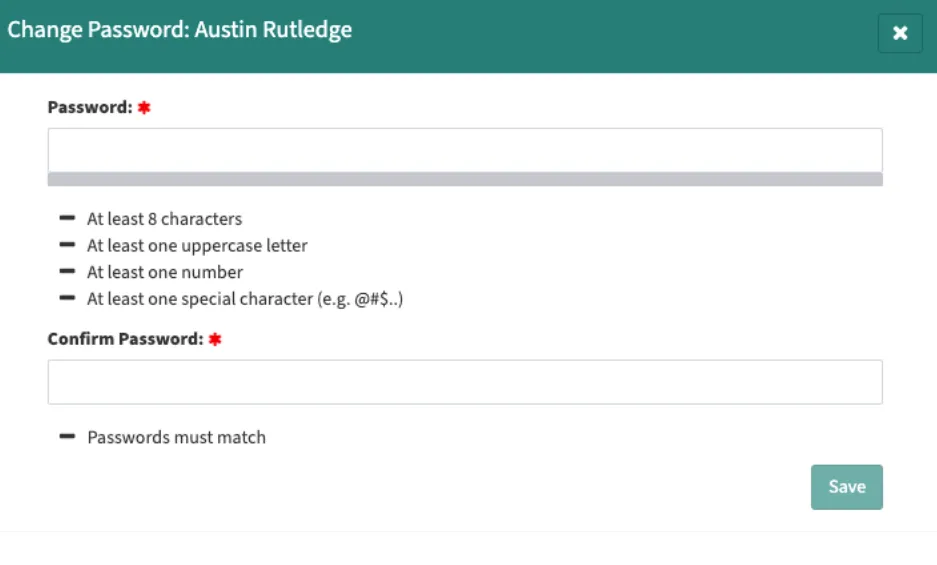
Note: This update will only apply to the use of local passwords. Anyone utilizing enterprise (or single sign-on) authentication will not be affected by this change. This update will also not impact any current local passwords. It will only affect future changes to local passwords.
New Look for the Calendar
In keeping with our goal to make Leo responsive and easy to use on any device, we are making some small changes to the Calendar. You may not even notice some of the changes, but the calendar will be easier to use, scroll and navigate on all devices. Some of the buttons at the top of the calendar have also moved, so if you can't find something, just click on the settings icon (gear wheel) on the top right. That’s where you’ll find all of the options for reports, filters, and adding personal and general events.
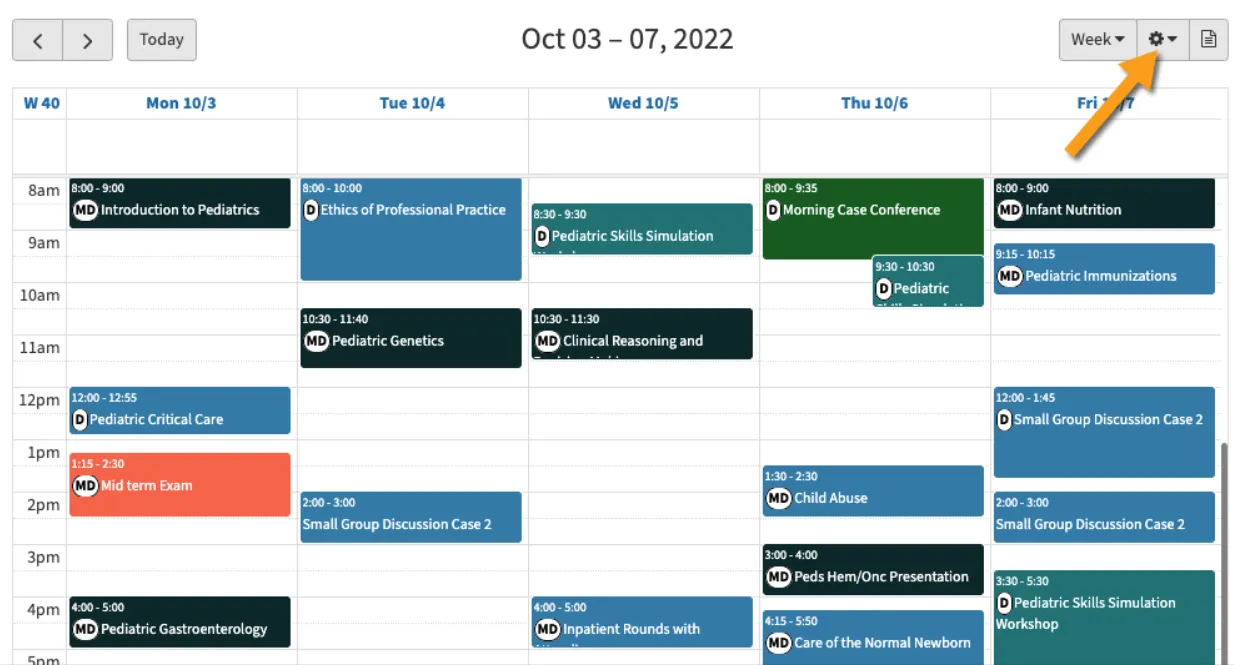
Allowed File Types
To further increase security in Leo, only specific file types will now be allowed in uploads to Leo. All major file types used for education are included in this list. If you have questions about the file types that are allowed for upload in Leo, please contact the Help Desk.
11/10/2022
We have been very busy since we shared product priorities with you at DaVinci Week and are excited to provide you with a sneak peek about some new features and enhancements to Leo that are coming your way soon. New features just in time for the new year!
New Look for the Calendar
We have made some minor but helpful changes to the calendar to improve your experience, regardless of the device you utilize. These minor updates will make the calendar easier to use, scroll and navigate on all devices.
Manage Evaluations Across Sections
We are excited to share that we are improving the evaluation management process. This was one of the areas of focus we announced during DaVinci Week and we can’t wait for you to see it. Once this feature is released, you will be able to manage and assign certain types of evaluations across sections from the Course Template level - saving you time and effort. We look forward to sharing more details with you soon.
Behind the Scenes Updates
As part of our continued focus on security, some updates are coming this weekend to your Preview systems. This release will include changes to how the As User function works, as well as increased security parameters for local passwords (single sign on is not impacted). More details will be shared in the coming days, so keep an eye on your inbox early next week for additional communication from us.
Over the winter break, we will be making some changes to Leo’s backend. There will be some downtime while we make these updates, however, we have taken steps to minimize the impact on your end users. More details will be sent via our help desk ticketing system, similar to how we notify you of OS updates.
See you at AAMC Learn Serve Lead in Nashville!
Come visit our CEO, Allison Wood and Hailey Diaz, Business Development Specialist, at our booth right at the front of the exhibit hall. Also keep an eye out for Alexis Rossi, CAO and Bekah Webster, Associate Director of Client Success, during sessions. We hope to connect with you in Nashville!
Keep your eyes on your inbox as more details about these new features and product enhancements will be coming soon. Please also note that our offices will be closed for the Thanksgiving holiday starting Wednesday Nov. 23.
8/23/2022
Track the duration of any Instructional Methodology utilized within an event. This additional level of detail provides more information on your CI report and allows you to more specifically divide up the instructional time within an event. For example, if you have one event that is part lecture and part large group discussion, you can now indicate exactly how much of that event was dedicated to each of those instructional methodologies - providing you with a detailed look at how your curriculum is being delivered.
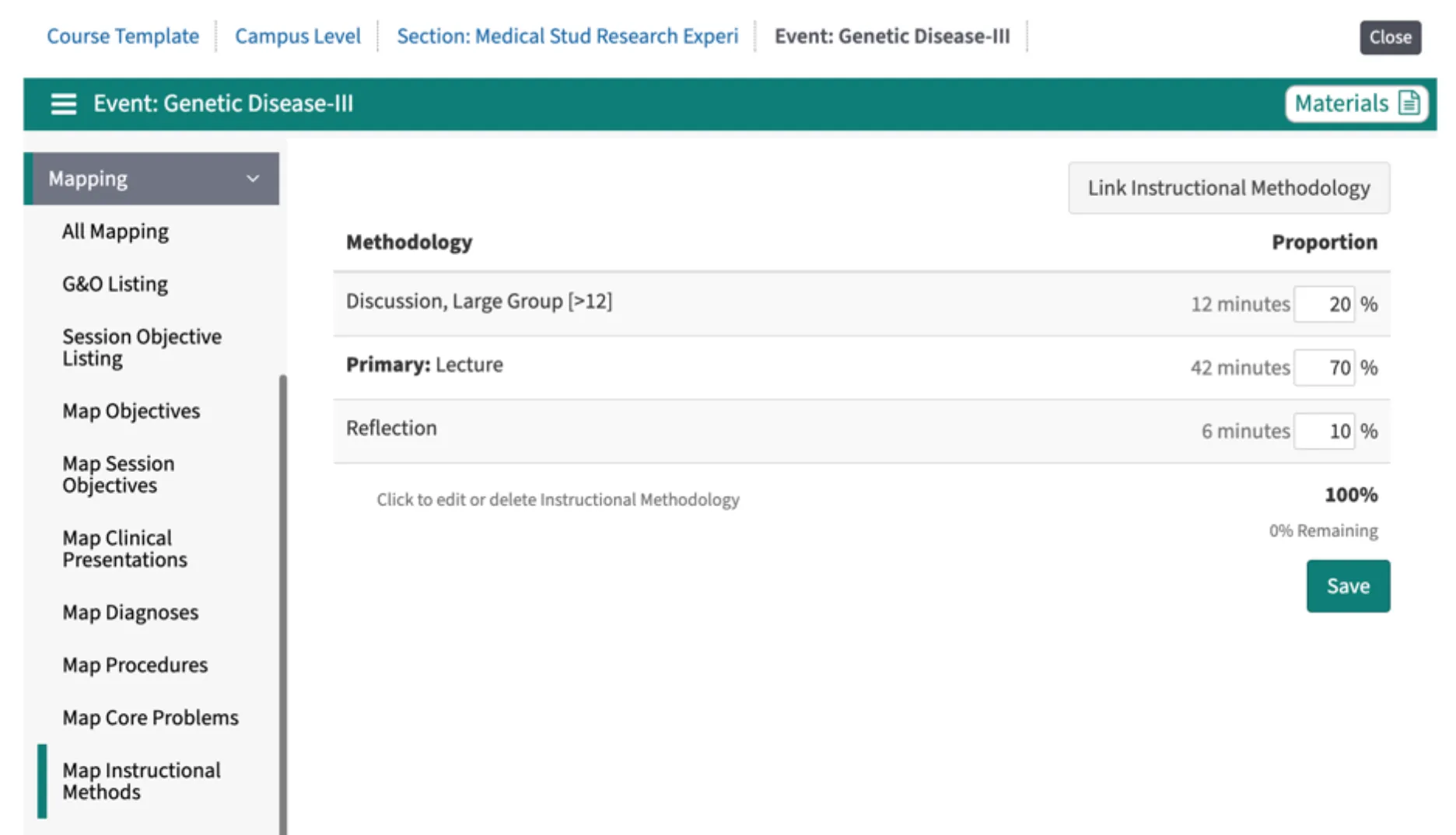
Existing IMs without a duration will remain unchanged. For the CI report, Leo will only report the IMs tagged to an event rather than how much of the instructional time was dedicated to that Instructional Methodology. If you are modifying existing IMs, for example adding one to an event, then a duration will be required in order to save your changes.
You can also set IM durations by Event Type to apply across all events of a particular type.
Learn more about Instructional Methodologies and duration here.
8/09/2022
You can now bulk import the CI Keywords as Themes into Leo! You can also designate which of the keywords should be included in your CI report.
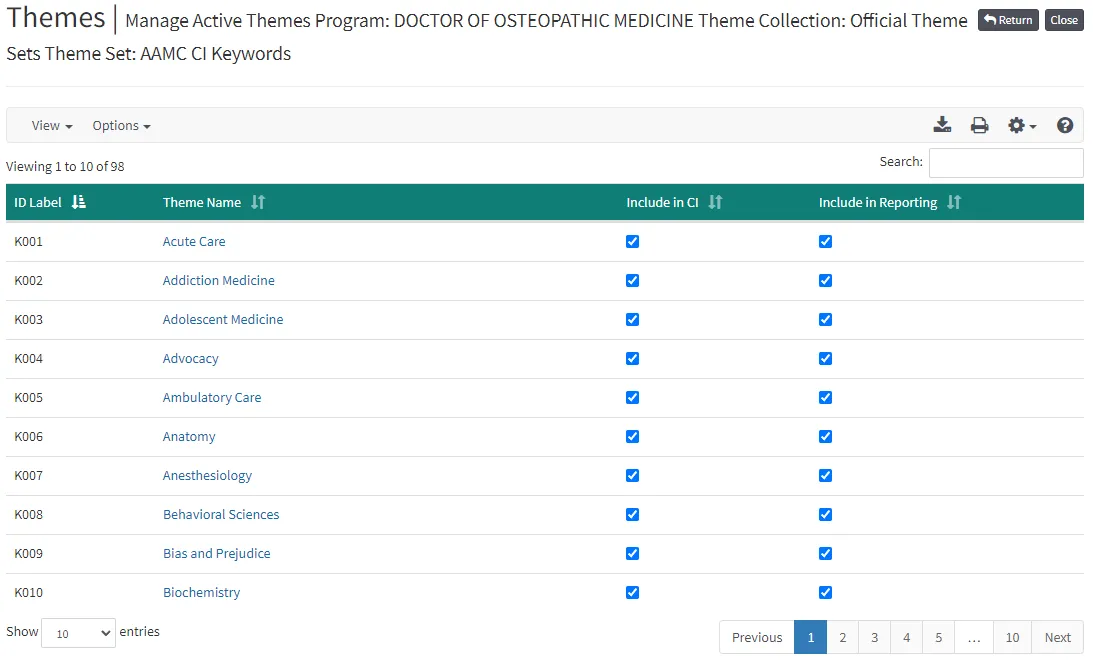
For more information on CI Keywords, how to create or import them as Themes, and how to track any COVID-19 related modifications from this past academic year, please visit our CI Keywords article in the User Guide.
Want to discuss how to use CI Keywords as Themes to track content or student progress across your curriculum? Have questions on how to map Themes for the AAMC CI report? Reach out to us on the Help Desk or request a meeting.
8/04/2022
The 2021-2022 AAMC Curriculum Inventory season officially opened this week on Monday August 1st! You can now access your AAMC CI Portal to update your team members, contact information and more. Please review the information to ensure that it is correct, especially for the signatory (typically a Dean). For more information about your CI Portal, the CI report and much more, check out the AAMC Curriculum Inventory site.
You can now bulk import the CI Keywords as Themes into Leo! You can also designate which of the keywords should be included in your CI report. For more information on CI Keywords, how to create or import them as Themes, and how to track COVID-19 related modifications from this past academic year, please visit our CI Keywords article in the User Guide.
The User Guide is also a great resource for learning more about the CI reporting process, as well as more detailed step-by-step information on building your CI report in Leo. We also offer 1:1 CI calls, where we walk you through the CI report set-up, review your curricular structure (i.e. Sequence Blocks) and share information about how to resolve any CI Business Rule exceptions. If you would like to schedule a CI call with us, please utilize our Meeting Request Form.
7/11/2022
We are excited to announce a new look and some big enhancements to the Gradebook in Leo!
The Gradebook now has a faster and easier to navigate user interface - you are going to love these updates. Building a gradebook and entering grades has never been easier!
Utilize the New Gradebook User Interface
The gradebook now offers easier-to-use scrolling functionality so you can quickly find students and assignments to check grades, comments, and update scores if needed. The headers and student names now stay locked in place as you scroll - making it easier to ensure that you are entering the correct score for the correct student. We’ve also added a search filter to the gradebook table so you can quickly focus on just a single student if needed.
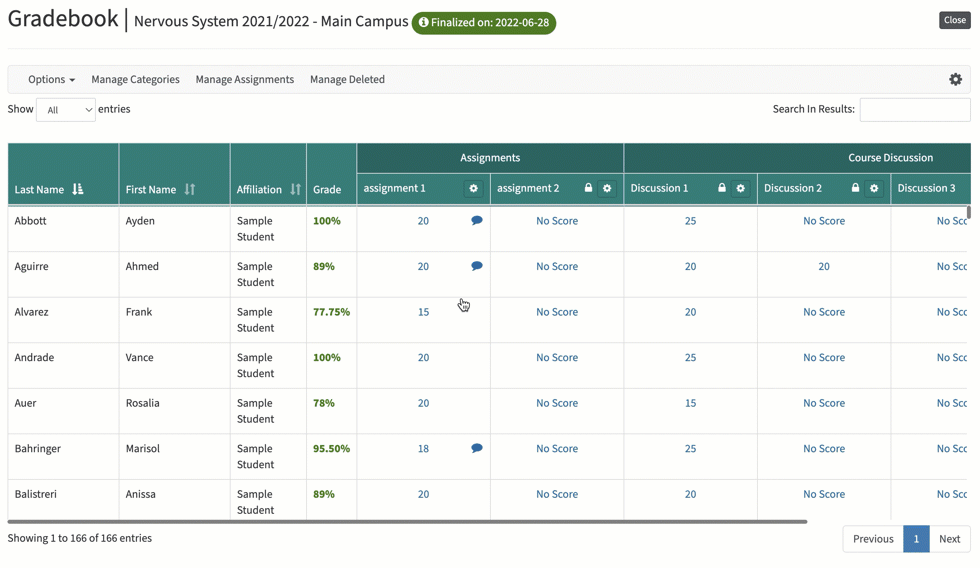
Manage Categories and Assignments
It is also now easier than ever to manage gradebook categories and assignments. You can manage all of the categories from a single screen, update percentages, add new categories, and release any category you want. Managing assignments has also gotten easier as we’ve brought all of the relevant information about each assignment to one screen to allow you to edit and add assignments with ease.
We’ve also added the ability for you to reorder assignments and categories right within the gradebook simply by dragging to sort them as you wish!

Update Scores with Ease
Even the score entry screen has gotten a new look. Now you can enter scores, alpha scores, and comments for multiple students at once. You can also easily copy a single score, alpha value, or comment to other students with the click of a button.
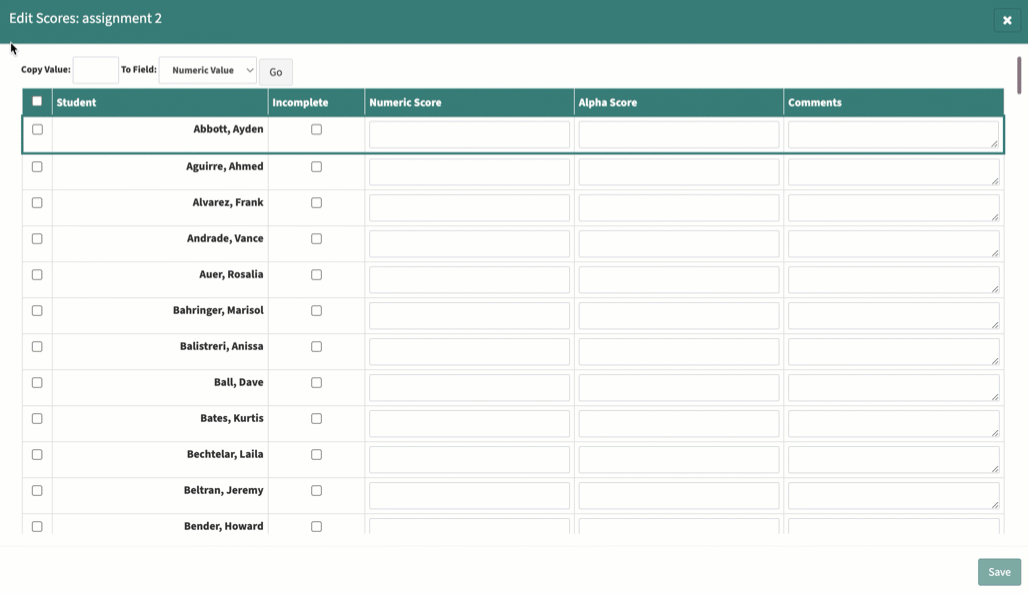
Use Bulk Actions to Save Time
Now you can export or import individual assignment scores along with alpha scores and comments - all at once! If you need to make updates to the entire gradebook, you can utilize the gradebook export/import functionality to download all of the assignments at once, make your changes, and upload the .csv file back into Leo to record the changes.
More Info
The new Leo Gradebook is now live in your production system. There are no settings or options you need to check - your gradebooks should automatically adjust to the new look and additional functionality!
We’ve updated the Leo User Guide to include the latest information to reflect the new user interface and functionality. Check out the Gradebook Overview article for more in-depth information, and read this article to learn how to use the new Edit Score window to update student assignment grades.
Mapping Functionality Update
In addition to the Gradebook updates, we have also added back the ability to modify G&O that have been directly mapped to an event. This functionality is temporary to help support mapping clean up ahead of the Curriculum Inventory report submission. As of this fall, we will again be restricting event mapping to only allow for session objectives. Please keep this in mind as you prepare for the upcoming academic year and let us know if you have any questions or would like to set up a meeting to discuss how best to transition away from directly mapping G&O to events.
7/7/2022
A friendly reminder that the new Gradebook user interface, including new functionality, will be going live in your Production systems this weekend!
In the meantime, please check out your Preview systems for the latest updates. You can also learn more about the new Gradebook functionality from the Leo User Guide:
Your current gradebook data will remain accessible in the new format. Please let us know via the help desk if you have any questions.
6/30/2022
As you know from our DaVinci Week presentations, our team is excited to share the new Gradebook with you - including new functionality that will support your everyday work. We have just updated your Preview systems with the latest enhancements and encourage you to check it out. Therefore, we are also providing you with additional time to explore the new Gradebook on your Preview systems. We anticipate that the new Gradebook will now be released to your Production systems the weekend of July 9th.
Once the new Gradebook release is applied to your Production systems, existing gradebook data will remain even as the updated functionality also becomes available. You can continue to create and utilize the current Gradebook in your Production systems - the new user interface updates will simply be applied to your existing gradebooks, providing you with additional tools to manage your data.
Here are some details on the new functionality from our User Guide to help you get to know your new Gradebook:
Please note that DaVinci Education will be closed on Friday July 1st and Monday July 4th.
6/15/2022
Please update your bookmarks!
Our Help Desk URL has changed to:
https://leosupport.zohodesk.com
As a reminder, you can also still email support@davinci-ed.com or check out our User Guide.
6/13/2022
Check out the Sneak Peak of the all new Gradebook interface live on your Preview Systems now!
We know how important a Gradebook is for an LMS and we think you’ll be pleased at how quickly the new Gradebook UI loads! This new interface provides several helpful upgrades including: Searching, Sorting by column, the ability to toggle columns on and off, freeze columns and headers, as well as more simplified menus.
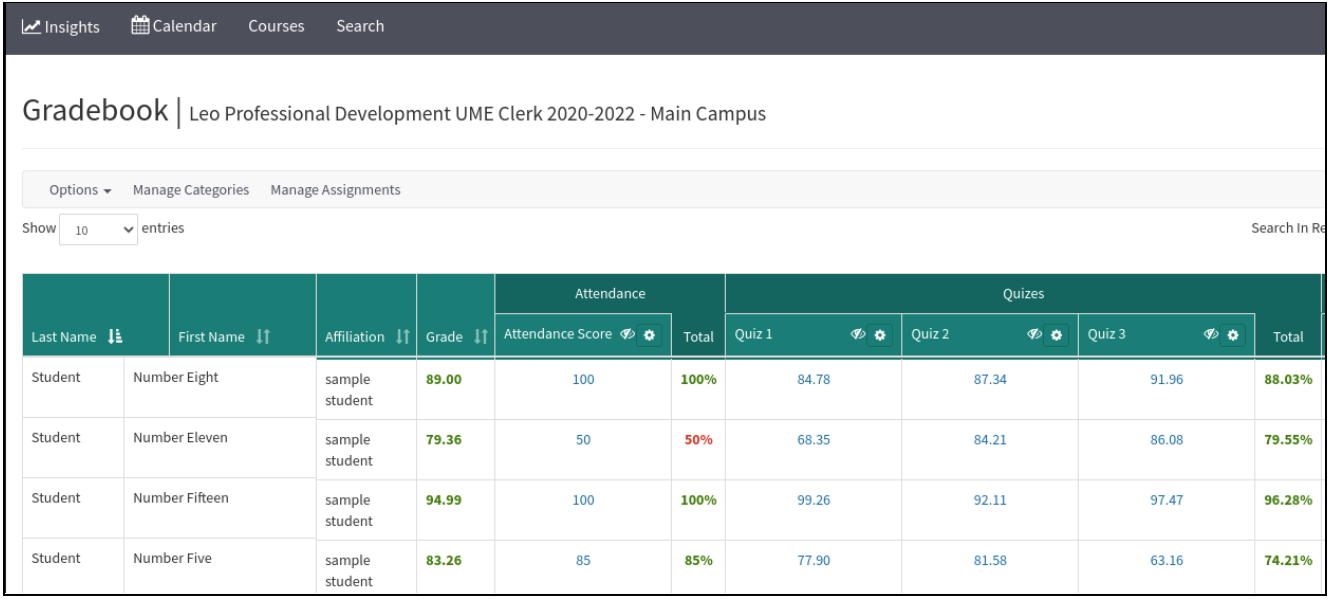
Managing Assignments and Categories within the Gradebook has never been easier! Now you have the ability to Search for Assignments or Categories, assign values, as well as drag and drop to reorder and move assignments across categories. We think you’ll love these new enhancements!
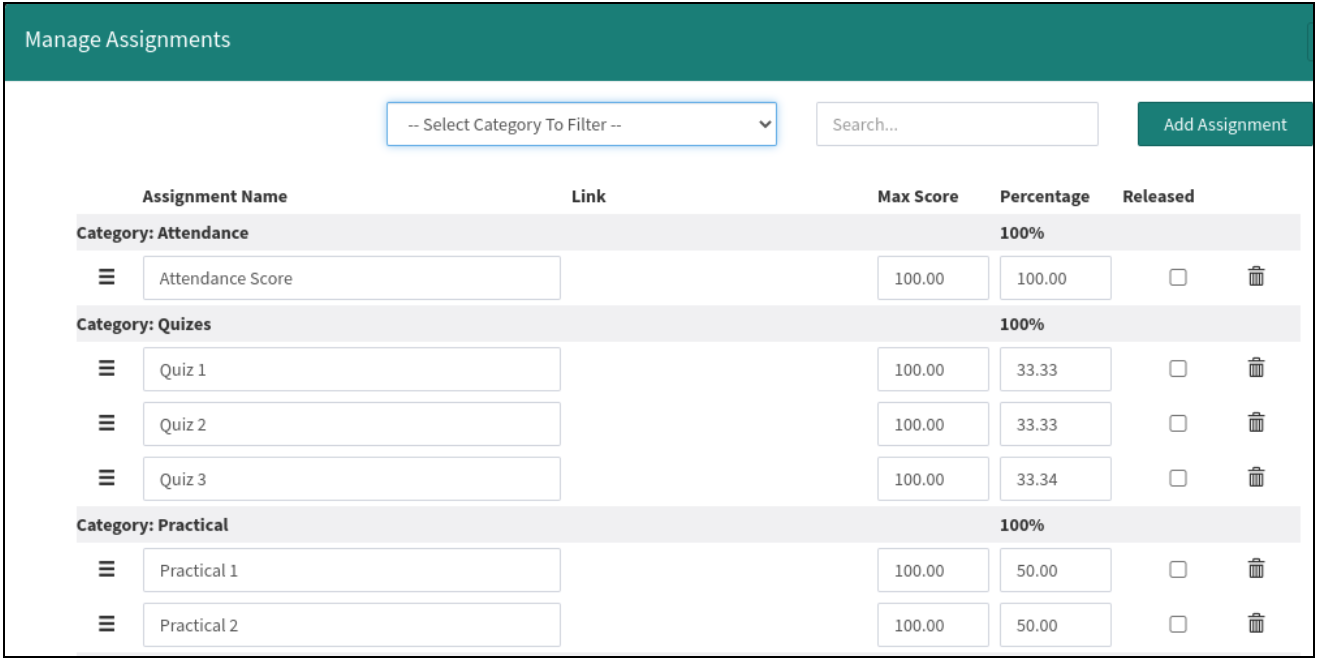
Because this update includes a new look for the Gradebook, we wanted to give you plenty of time to view the changes and try it out on your Preview system before it goes live in your Production system. Please note that we are still actively working on some final features and functionality, as well as some polishing of the UI, over the next couple of weeks prior to the Production release.
All of these updates are now live on your Preview system and will appear in Production later this month. If you would like us to pause your Production refresh to your Preview system in order to preserve work done in the Preview system during this time, please let us know via the Helpdesk.
More details will be available in the User Guide soon.
As a reminder, our Help Desk URL is changing on June 15 to: https://leo.zohodesk.com
Also, please note that the new mapping functionality is now live on your Production systems.
6/9/2022
As you may have heard from our Monday kickoff to DaVinci Week, we have a lot to share with you over the next few weeks - starting with new mapping functionality and Curriculum Inventory (CI) related updates that are currently live on your Preview systems.
New Curriculum Mapping Functionality
Based on the new business rules for the AAMC Curriculum Inventory (CI) Report, we have integrated updates to the CI module in Leo. Nothing to do here on your end, this information will automatically be applied to your CI data before submission.
We have also developed a more detailed way to track Instructional Methodology (IM) duration within a learning event. Now you can more clearly distinguish between primary and secondary IMs based on the time spent utilizing each methodology, which can be set per event or per event type as a percentage of the event duration.

New functionality for Themes, like the bulk import and new fields for ID Label and Source, help you utilize standard keyword sets such as the CI Keywords. We have also added the entire set of AOA Competencies into your Competency Repository to aid our Osteopathic schools in using the crosswalk to map to PCRS for the CI report. Additionally, you also now have the (optional) ability to identify Goals in Leo as Program Objective Domains in the Curriculum Inventory.
The most significant change in mapping is the new ability to create Course Objectives! Bulk upload unique Course Objectives by course, link to your Program Objectives (G&O) and your Session Objectives to add another, more detailed layer to your mapping.

The newly added mapping level of Course Objectives will be included in the Curriculum Inventory as Sequence Block Level Expectations, as well as has been integrated into the relevant Leo mapping reports.
Please note that once you turn on Course Objectives, you will no longer be able to map G&O directly to courses and events.
Also in this update:
Evaluation User Status Report
We’ve also added a new report to track evaluation completion status for users as well as the ability to sort, search and filter on type, status, specific evaluation, evaluator/evaluatee, date range and more!
Changes to Bulk Data Import for events
Bulk import options for events have moved and are now available within the Course Section (no longer under “Data Entry > Data Import”).
All of these updates are now live on your Preview system and will appear in Production this weekend, June 11.
More details regarding these new features and functionality will be available in the User Guide soon.
Please note - our Help Desk URL is changing on June 15 to: https://leo.zohodesk.com
4/4/2022
We are happy to announce that the new Evaluation Editor is now live on your Production system! Please see the video below for a quick overview of the new functionality that you can now access to create, edit and preview your evaluation templates.
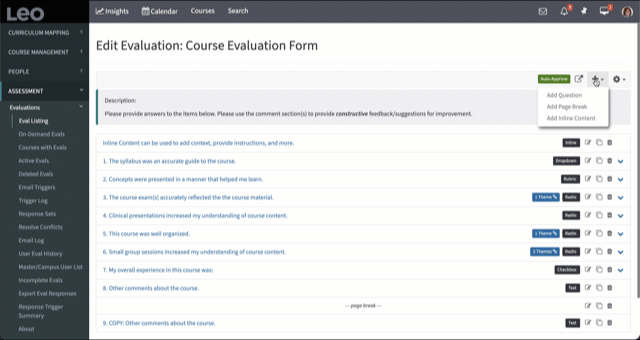
Please see our updated User Guide article on creating/editing an evaluation for more details.
If you have any questions, please reach out to us via our helpdesk.
3/30/2022
We are excited to share that the all new Evaluation Editor will be going live on your Production systems this weekend! This mobile-friendly editor helps you create, modify and preview your evaluation templates in a one-page, user-friendly format. Drag and drop questions, answers and page breaks to customize your evaluation form, add sip logic to pages and questions to adjust the flow, track your Themes and much more!
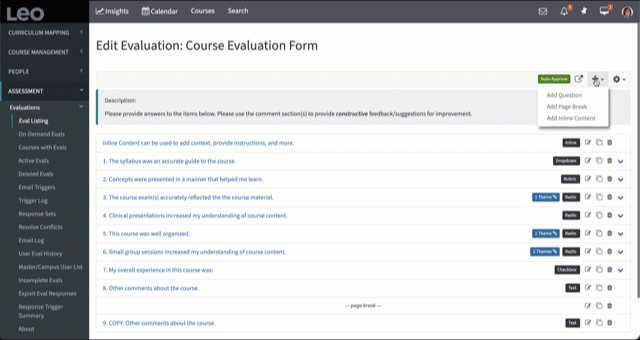
As a reminder, because we’ve added some new options for questions, the Evaluation Editor contains new and updated database fields. Therefore, please double check any existing skip logic within your evaluation templates in your Preview system ahead of this weekend's release. If you notice anything unexpected, please reach out to us via the helpdesk.
For more information, please visit our User Guide articles:
If you have any questions, please reach out to us via our helpdesk.
3/22/2022
We have very exciting news! The all new Evaluation Editor is now live on your Preview system. This new editor provides user-friendly tools to help you effectively create, edit and review evaluations.
All New Look
The Eval Editor’s user interface has been completely overhauled to make it easier than ever to create or edit an evaluation template. We have removed all the different tabs for blocks, questions and pages, integrating everything into one menu.
From this one screen, you can add, edit or copy questions, insert page breaks or inline content, or preview the evaluation. The new labels help you navigate to certain question types, identify questions with themes, and track your skip logic.
Drag and drop questions to quickly reorder them. You can also drag and drop page breaks, move questions across pages, and re-order question responses with ease.

You can also toggle your evaluation description on or off. Remember, this is a rich text editor so you can insert videos, format text and more!
Question Types & Scoring Updates
This update also streamlines the available question types and provides additional flexibility for scoring. Since you can now choose how to score questions, you no longer have to choose a certain question type in order to utilize specific score options. For example, instead of using TallyOne, you can choose Radio and to summarize by count. If you summarize Radio, Dropdown, or Rubric questions by average you can also decide whether the question will be included in the overall summary eval score.
The chart below details how the Tally questions have been integrated into other question types.
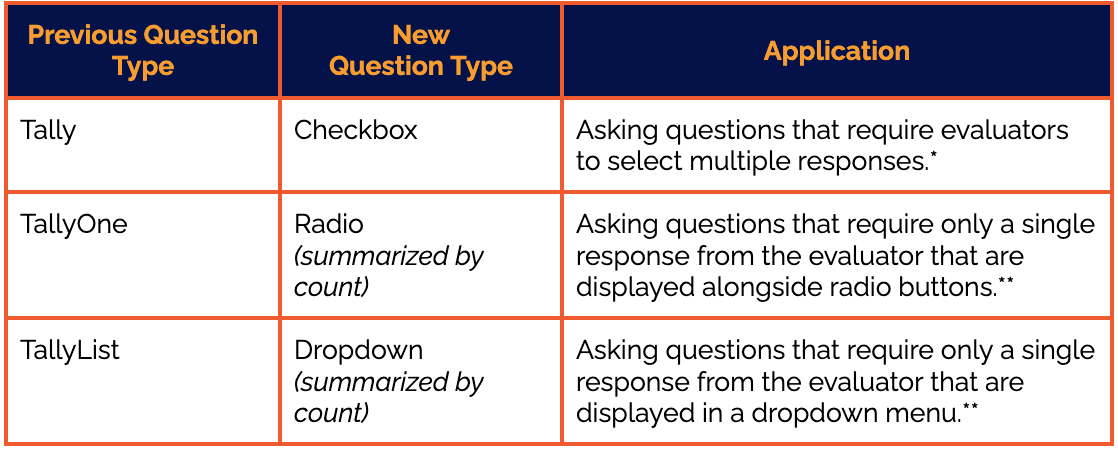
*Checkbox questions can only be summarized by count and cannot be included in scoring.
**Radio and Dropdown questions can be summarized by average or count. If they are summarized by count, they cannot be included in scoring. If they are summarized by average, you can decide if you want to include that question in scoring.
Other Question Types
Rubric and Text questions are still there. Rubric questions will always be included in scoring and the only option for summarizing rubric questions is by average. Of course, options for scoring don’t apply to Text questions.
Transferring Old Evaluations into the New Editor
All your existing evaluation templates will automatically be transferred to the new evaluation editor, allowing you to edit with ease! We recommend taking a look at your evaluations on your Preview system to ensure that they are displaying as expected. Please reach out to us on the Helpdesk with any questions or concerns.
More Information
The new evaluation editor is now available on your Preview system and will be live on your Production system the weekend of April 2nd. If you would like us to pause your Production refresh to the Preview system in order to preserve work done in the Preview system during this time, please let us know via the Helpdesk.
In the meantime, check out these updated User Guide articles for more information.
1/31/2022
We're happy to announce enhancements to Leo’s Patient Encounter Tracking (PET).
Patient Encounter Tracking now has a new mobile friendly, responsive interface, supporting utilization in the clinical setting.

Students can create new entries directly from the PET tab without needing to drill down by course. Adding new PET entries and duty hours has never been easier.
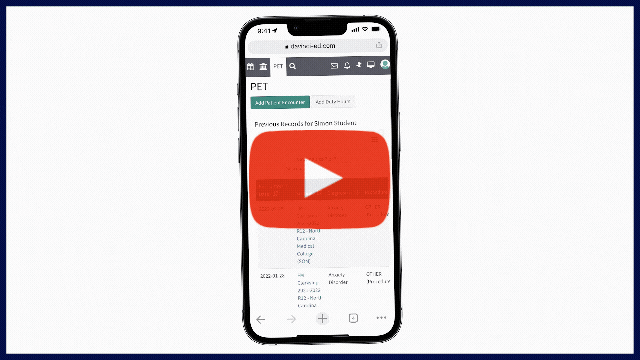
The PET tab is now visible for students who have PET-enabled courses - regardless of whether the enabled course is considered an "active" course. Access all of your PET entries at any time.
We also wanted to make you aware of a change in the Admin Toolbar. The “PET Master Report”, which includes all fields for every PET entry, will be renamed to “PET Activity by Year”. It will still have all the PET information you expect to see, and is filtered by selecting an Academic Year to access the report. Path: Admin Toolbar > Advanced > PET Administration > Reports > PET Activity by Year. Please be reminded that this report can be quite large and may take some time to populate. Like most other reports in Leo, there is also a download option available.
All of these enhancements to PET are currently available on your Preview system and will be live on your Production system this coming weekend. If you have any questions, please let us know through our helpdesk.
More details about these PET updates can also be found in our User Guide:
Student > PET Tab: https://lcmsplus.screenstepslive.com/s/18500/a/805393-pet-tab
Account Manager > PET > Modern UI: https://lcmsplus.screenstepslive.com/s/18500/a/875287-pet
11/22/2021
It’s almost that time of year again, lottery season! To help you prepare for your upcoming lotteries, we have made a few improvements. All updates have been installed on your Production system and you can check out our User Guide articles to learn more.
Rank Distribution:
We have updated sorting on rank distribution charts, as well as added it to the finalized lottery screen, so that you can access this data even after you have finalized a lottery.

Consistency updates:
We know that running lotteries can be stressful, especially with a ton of elements to manage. To ease the burden, we have reviewed our lottery module and made some adjustments so that language, buttons and other UI tools are more consistent. For example, we have made the difference between lotteries that are open, in preview, or finalized more clear, as well as updated your options to move a lottery from one status to the next.
Set conflicts:
Set conflicts ahead of time to ensure that students only see the available elements relevant to their schedule. For example, if you have students that get priority for certain courses in a block lottery, but not all, they can still participate in the lottery - as long as you add those particular elements as conflicts. If you are planning to run block lotteries - and have overlapping blocks - this feature is helpful for ensuring students don’t accidentally pick a course that overlaps with one in which they are already enrolled.
From the lottery manager, go to Elements > Options > Conflicts to manage which course sections should show up as conflicts and prevent your students from ranking elements that overlap those sections.

10/27/2021
To provide additional insight into longitudinal student performance, you now have the ability to tag assignments with themes in Leo. For any event that has been mapped with themes, those themes are now automatically available to tag any assignment associated with that event. For more information on how to tag themes to an assignment, check out our User Guide article on creating an assignment.
You can also now track student performance on assignments by theme in the Academic Portrait to gain additional information about a student’s areas of strength and potential gaps in knowledge over time. Filter by theme (#1) to see performance data related to a specific content area or EPA for example. Navigate back (#2) to the Themes tab overview to see more information or choose another performance area to explore. View scores and comments (#3) of each assignment, or navigate to the corresponding course or event (#4) for additional details.

For a more holistic understanding of student performance, use themes to tag procedures, diagnoses, evaluation questions, events and courses! For detailed information about accessing longitudinal student performance data on assignments and more, visit our User Guide article on the Academic Portrait.
9/10/2021
We’re continuing to add more insights to your students’ Academic Portrait!
The Themes tab in the Academic Portrait lets you select any Theme from your curriculum to see how a student has been evaluated over time - and provides links to all of the student’s events related to that particular Theme.
Now - if the student is using Leo to track patient encounters - you can also see all of their recorded Procedures and Diagnoses related to that Theme.

In the Academic Portrait, you’ll find new links for Procedures and Diagnoses under the Themes tab - if the student is enrolled in a course that has Patient Encounter Tracking (PET) enabled.
Select the Theme you want to view, then the numbers in each tile will update to correspond with the data linked to that Theme. You can then view the evaluation questions, events, diagnoses or procedures for the Theme. For more information regarding the student view, please see the updated My Portrait user guide article. If you wish to send information out to faculty, we recommend using the Portrait Listing user guide article.
To get started, you’ll need to map Themes to your system’s Diagnoses and Procedures. Go to ADVANCED > PET Administration > Diagnoses (or Procedures) and click on any Diagnosis (or Procedure) - then select Assign Themes.
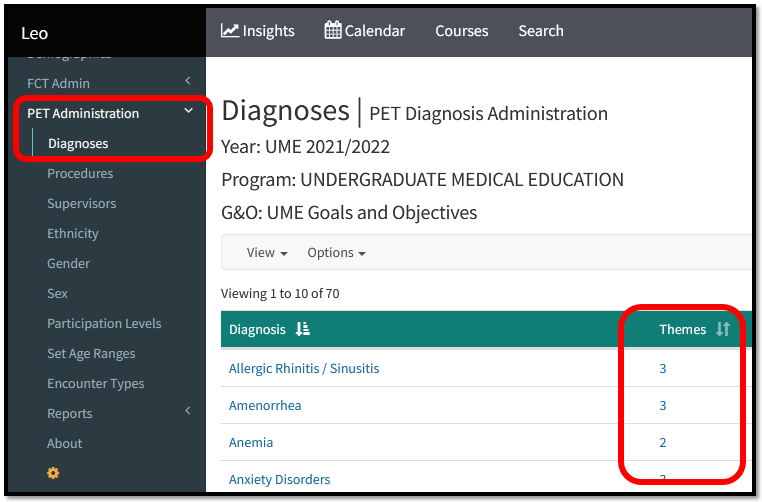
For more additional information on how to tag Diagnoses and Procedures with Themes, please see this user guide article.
Also in this update:
We’ve added direct links for every comment left by evaluators under both the Evaluations and Themes tabs in the Academic Portrait.

Look for the speech bubble icon to view evaluator comments!
8/20/2021
Leo’s Academic Portrait™ now includes more data visualization to provide insight into how students are progressing - and how they compare to their peers.
These updates are now live on your Preview system, and will appear in Production this weekend, August 22.
Academics:

When you click on the overall grade for any course under the Academics tab, Leo now shows you a complete view of that student’s achievement in the course. You can see their grades for each assignment or exam, complete with category scores.
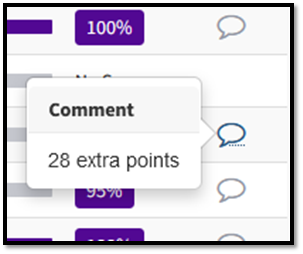
You also have the option to turn on comparison data for grades within the course. At a glance, you can see how the student’s performance compares to their peers.
Any comments left in the gradebook are also accessible here, by hovering over the voice bubble icon.
Evaluations:
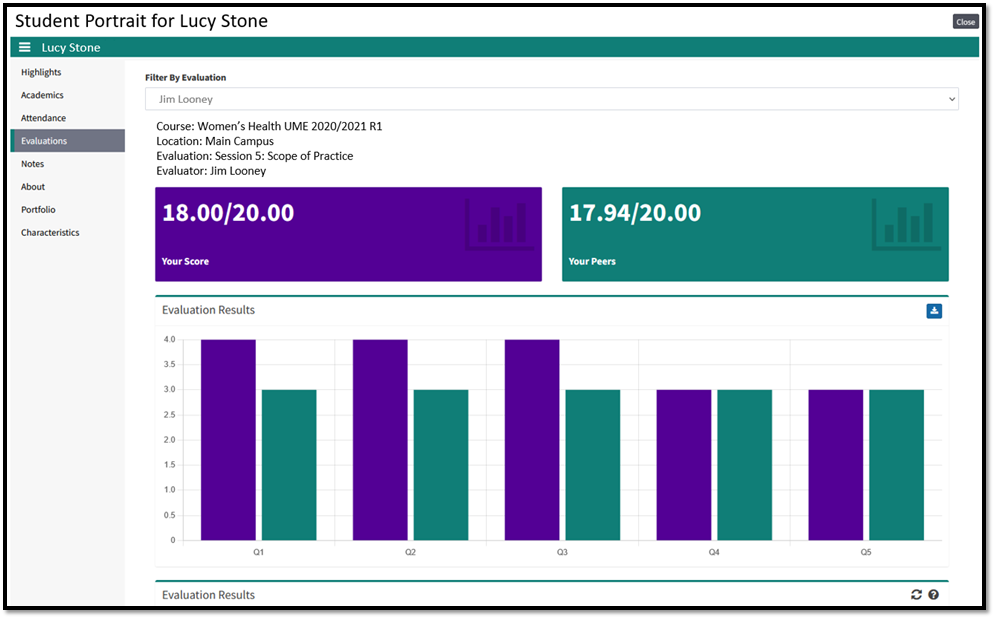
When clicking on the name of any completed eval under the Evaluations tab, you’ll see a new display that shows all of the responses from the eval in a more easily-digestible format for students and advisors. Students can see the value associated with each question and how they were rated and scored.
7/8/2021
We know that continued professional development is an important part of any educational program. DaVinci Education is happy to announce new resources and features to help you support your faculty and staff.
Professional Development Training Course
While you may already be familiar with our Student Orientation training materials, did you know that we now offer interactive modules for training faculty and staff? By completing these modules, faculty and staff will gain important knowledge about how to use Leo, including information on how to upload materials, use embeddable media, create discussions, navigate through the system and much more.
We have created the resources for you, including a way to track completion, so that you can pick and choose which subject-based modules you want to utilize. Leo can serve as your platform for content delivery, allowing you to create a professional development or faculty/staff orientation course that suits the needs of your institution, and various user groups. Create a space where incoming faculty can get acquainted with Leo and your current team can get a refresher or learn new skills.
For more information on how to create a professional development course in Leo and utilize these modules, please visit the User Guide.
Faculty Portrait
We have adapted the Academic Portrait for faculty, providing a space that they can make uniquely theirs. The new Faculty Portrait is open to all users in the system who are in a faculty or staff role. Just as you can turn tabs on and off in the Academic Portrait for students, you can do the same for the Faculty Portrait - adapting it to your institution’s needs.

Available tabs include:
- Highlights: a quick peek here provides the faculty member’s picture, contact information, pronouns, associated program and any related affiliations.
- Info: this space has a rich text editor, allowing faculty to creatively design their own page and showcase any information that they wish to share.
- Workload: displays any courses and events that the faculty member is assigned to, keeping track of all teaching responsibilities in one page.
- Evaluations: includes any evaluation that the individual has completed or needs to complete, as well as any evaluations that have been done on this faculty member, allowing one to track and access student and peer feedback at any time.
- About: mirroring the Academic Portrait, this section is customizable by each institution and will pull information from the Demographics in Leo.
- Publications: lists and links out to a faculty member's publications from PubMed via their assigned ORCID Identifier (PubMed Author Identifier).
- Documents: essentially a portfolio, faculty members can upload various documentation all in one place. Ideal for a CV, awards, reference letters, teaching materials and other items needed for the promotion and tenure process.
For more information and step-by-step instructions on how to customize Faculty Portraits for your team, please visit the User Guide.
5/19/2021
Our Student Orientation course is back and better than ever! We have updated the course content to include Leo’s new features, as well as added more interactive exercises.
Customize the information you want your students to know by choosing from a series of pre-created modules on various topics, including: an introduction to Leo, events, the Academic Portrait, Patient Encounter Tracking (PET) and more! To learn more about each module, visit the User Guide article, where you will find a description and learning objectives for each module.
Create a student orientation course quickly by uploading the modules you want to share. Materials already include content, exercises, descriptions and more.
Track completion of modules with our built-in attestation form. Students who complete the module and fill out the form will receive a certificate of completion that can be uploaded as an assignment in the orientation course or into a portfolio in the Academic Portrait.
Learn more about different ways to utilize these modules, as well as advice on creating a student orientation course in Leo, by visiting our new blog post.
3/21/2021
Introducing the Insights Dashboard from DaVinci Education:
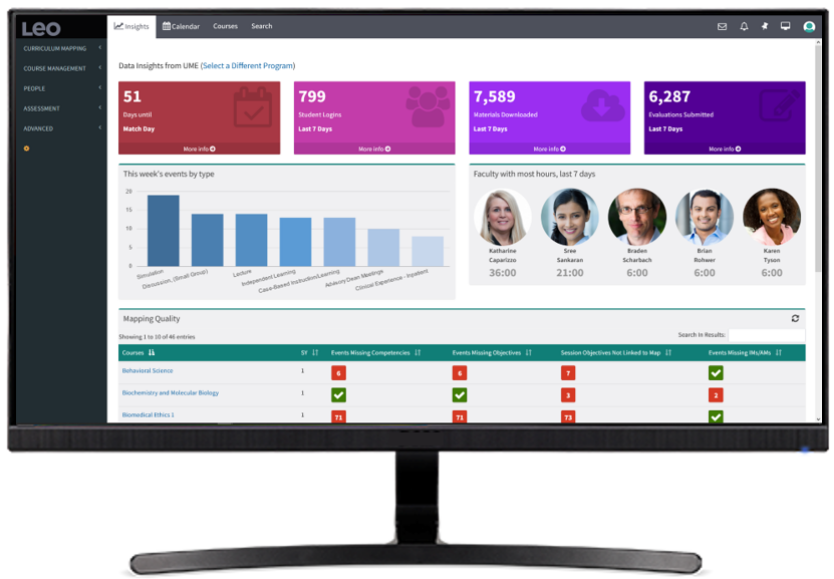
Available to administrators, the Insights Dashboard helps you stay Accreditation Ready Always™ with critical information, including:
📈 Curriculum mapping quality
📈 Faculty workload
📈 Days until important events
📈 Recent instructional events
📈 Leo utilization
You’ve entrusted Leo with data on every facet of your curriculum, and this is just the first of many forthcoming data visualization tools in Leo that will help you turn that data into information you can use to drive decisions about your program, your students and your faculty.
The Insights Dashboard is now live and easy to configure - check out our User Guide for more details.
Also new:
Fast Feedback Emails to Students:
Now Leo will send an email to students as soon as they’ve been evaluated - a link in the email will take them directly to the evaluation results.
When approving evaluations, the evaluator of record will see a checkbox right next to the Approve button. If checked, then the student who was evaluated will receive an email with a URL that will securely log them into Leo to view the results of their evaluation.

Pronouns:
We’ve added a field for Pronouns in the User Profile:
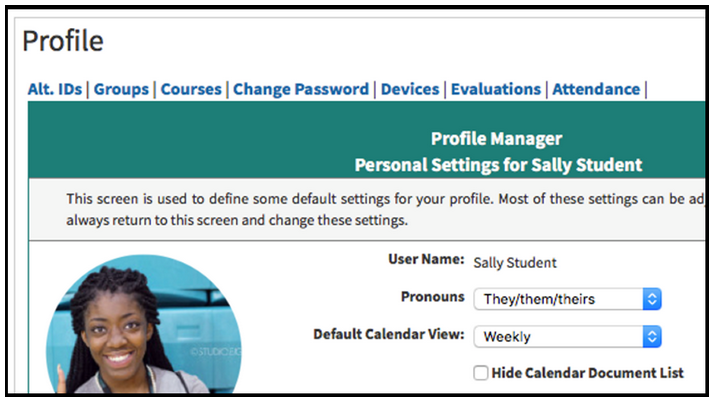
Each user can select their own Pronouns, or decline to answer. The student’s pronouns will also appear on the Academic Portrait, making it easier to engage in inclusive communication. More info on Pronouns in Leo can be found here.
1/26/2021
Here’s everything you need to know to take full advantage of the new functionality in Leo:
Location Map:
To ensure accuracy for the integrated Google maps, each Location needs to have an associated address. To check the Locations in your system for addresses, go to Admin Toolbar > Advanced > Location Management from here you can access the List All Locations report or search by location name to review or add an address. Once an address has been added, the Google map on the Details page in an event will update to show the location.
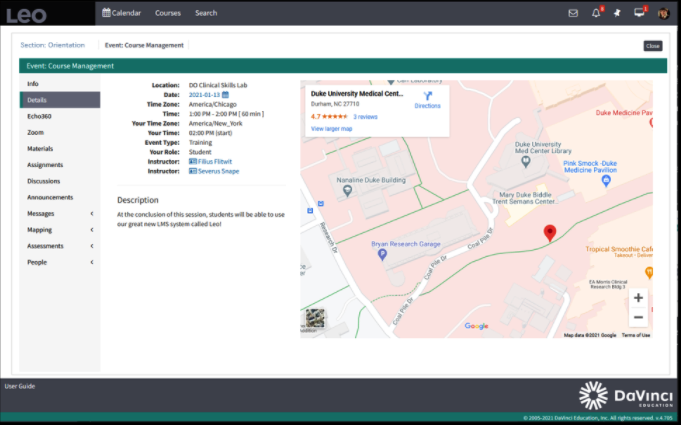
You can update your Locations list at any time, including in advance of the Feb. 1st release. The more address details you provide (i.e. street address and zip code, etc.), the more accurate the map will be.
Enable LTI:
In an Event, go to Settings > LTI Links > Options > Add
Have multiple providers? Not a problem! Follow the process detailed below to add each of your LTI providers and a new button/tab will appear in the left hand menu.
For example, Zoom:
You'll have to set up Zoom as an LTI provider in your system's Advanced Settings - we can help if you haven't done that part yet! Then to set up a new Zoom link in an event, you'll go to Settings > LTI Links > Options > Add. Select Zoom from the dropdown. You can give your meeting a custom name - otherwise it'll just be named for the Event. Click Save.
Now when students and faculty login, they'll see Zoom as one of the menu options for your Event.
Faculty: Just click Zoom and Start to kick off the meeting. Leo will recognize them as faculty and make them Host.
Students: Just click Zoom and Join. Leo will tell Zoom their names, and Zoom will keep track of attendance.
No more juggling passwords - Leo securely logs in your users.
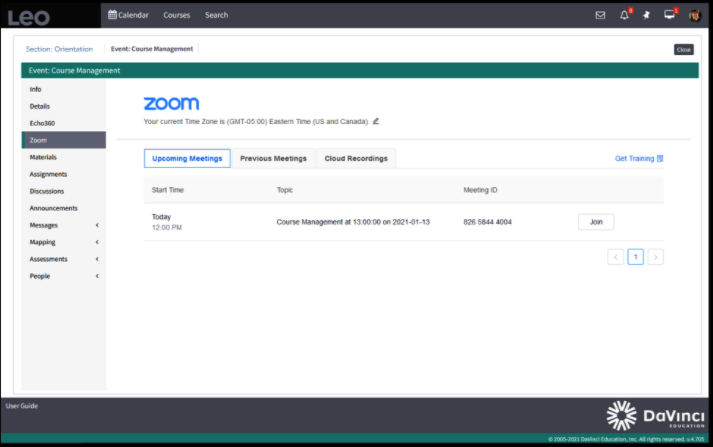
Info Page:
Each event can be customized to show your choice of landing page. For example, if embedding videos, interactive ed tech tools or other rich html content, the Info screen can be set as the main landing page for the event and will be the first thing that students see when they get to that event, like in the screenshot below:

To set a default menu item as the landing page for the event screen: in an Event go to Settings > Display Options > [choose the page you want in the Set default menu item for this screen dropdown] > Save Info
For example, if materials are the most important information to get to students, you can set that as the event landing page or set the Info page as the landing page to take advantage of the ability to use rich html content and tools. Since this is configured on an event by event basis, faculty can choose the landing page that works best for delivering the content to students for that particular event.
Note: for CI related purposes, the Description field on the Details page should be plain text only. The new Info page is the best place for rich html content.
12/21/2020
Does your school use tabular rubric-style assessments when tracking student performance on competencies? Maybe even with pen and paper?

Look familiar? Now you can put away the pad.
DaVinci Education is happy to introduce our new Mobile-Optimized Rubrics.
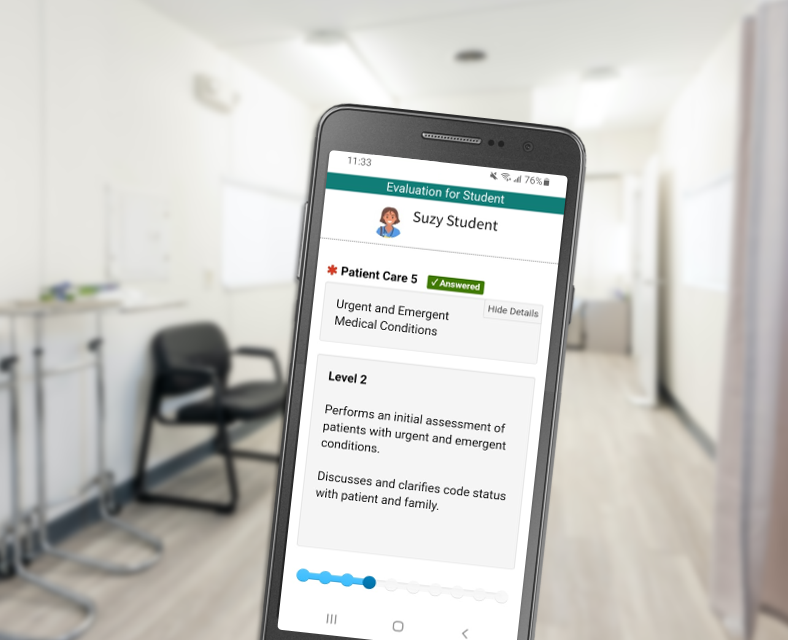
Designed to make it easy to rate students on the go, our Rubrics tool gives your evaluators a simple slider they can use to view rubric details by level and make their selection.
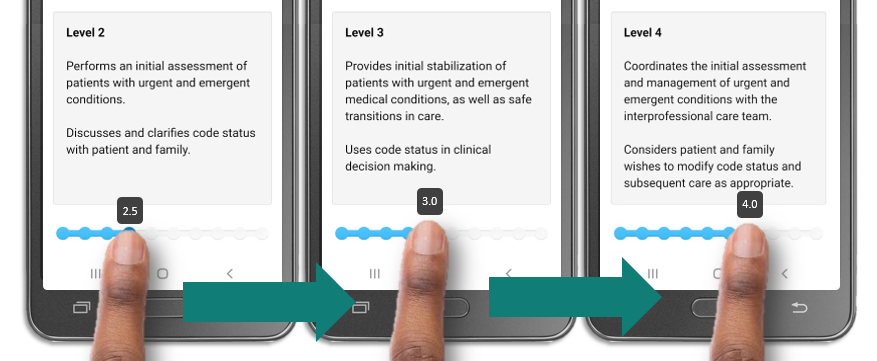
Plus you get a ton of options:
- Space to include detailed instructions for each question.
- Require a comment with every rating.
- Require a comment even if there’s no rating.
- Use integers or decimals in your scale.
- Add as many steps as you’d like.
- Assign each step any numerical value.
Because Rubrics are part of the full suite of evaluation tools in Leo™ you can mix and match with other question types, assign them to any Leo user, or make them available as an On Demand evaluation for workplace-based assessments. The data stays in Leo and becomes part of each student’s Academic Portrait™.
We’ve even added some full sample response sets to get you started.
For more information about setting up Rubrics in Leo, check out this article in our User Guide.
11/5/2020
We have now added the ability to grade discussions in Leo!
Best of all - it’s very simple to set up, and quick to use.
Setting it up:
When creating or editing a discussion, you just need to flip the option for Graded Discussion to “Yes” and enter a number value for the maximum points to be awarded (from which you’ll base your grades).
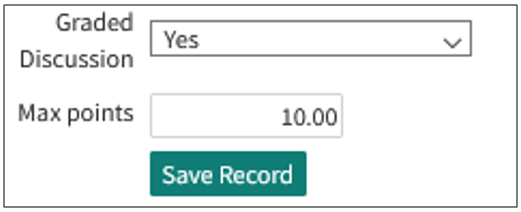
Entering grades:
Then, on the Discussion screen, click the checkmark icon in the upper right.

You’ll see a new screen that shows you how many posts each student has contributed to the discussion - and fields where you can enter a score, along with any comments.
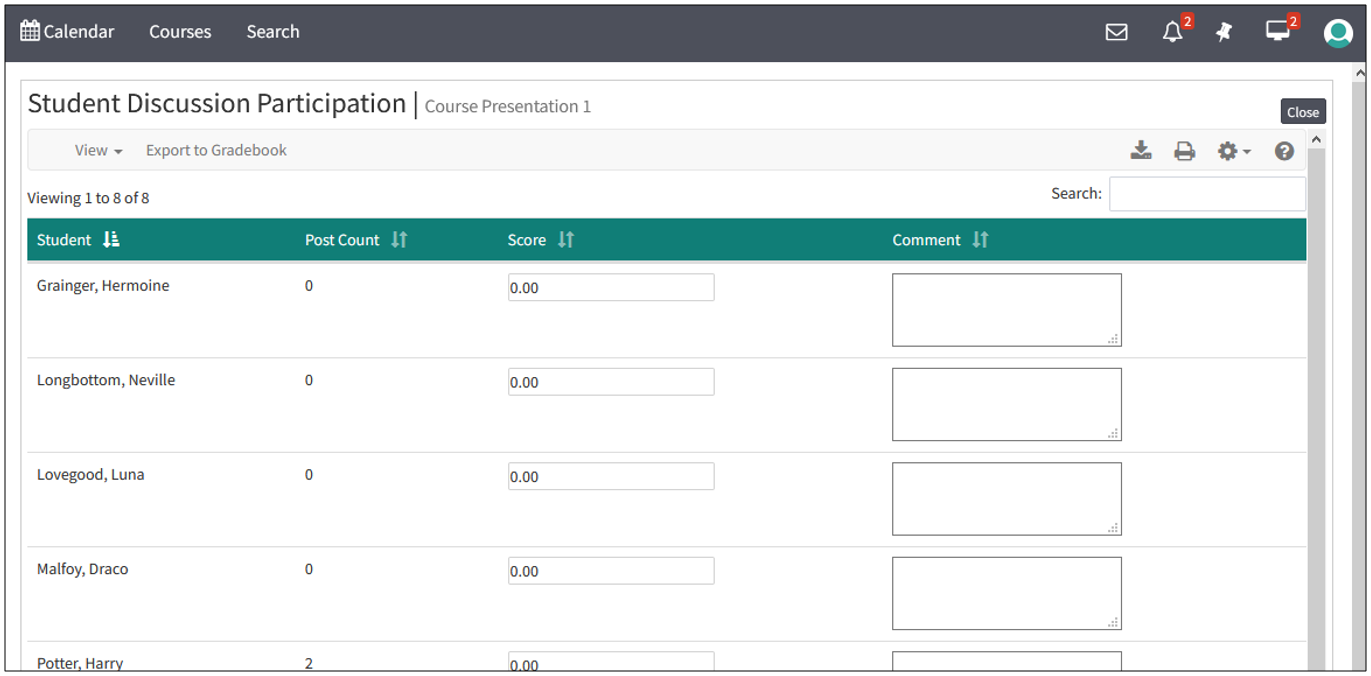
Click Export to Gradebook and you’re done!
For full details on how to use Graded Discussions, check out the Leo User Guide.
10/16/2020
Today we’re unveiling a new mobile-friendly and convenient solution for clinical faculty to complete evaluations on the fly, right in Leo.
The Leo Evaluation Portal has been given a new responsive interface - and when you enable On-Demand evaluations in your Account Manager, you’ll see new options:
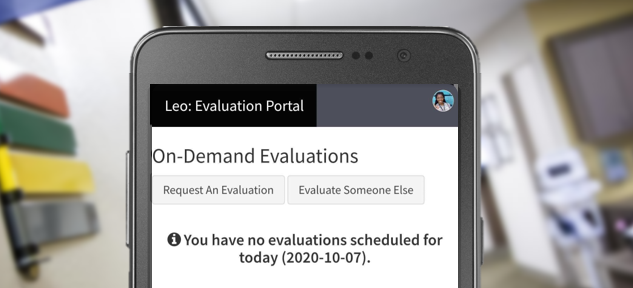
Students can select Request An Evaluation to open a simple form and fill in any needed information. There’s also an option to Evaluate Someone Else that can be enabled for students or faculty to generate an evaluation on the spot.

For Clinical Faculty, it’s as easy as opening their email. They receive a secure link immediately after the student requests to be evaluated. That link gives them one-click access to the evaluation requested by the student. And because Leo’s evals are already mobile-friendly, faculty can easily complete the evaluation and submit right from their phone.
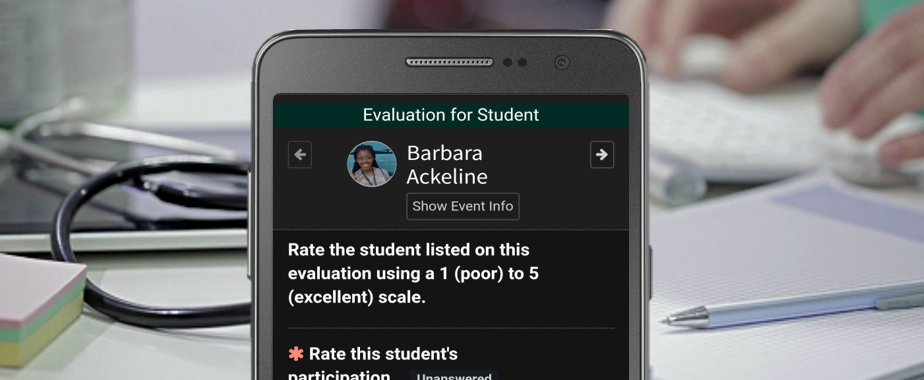
Here’s what else you should know about Leo’s new On-Demand Evaluations:
- Completely Customizable: You can enable or disable these tools in different programs or courses, for students or for faculty.
- Flexible: Use them for tracking professional competencies, progress on EPAs, or any other function for when you need a light-weight formative assessment tool.
- No Guesswork: If your users can access their email, they can respond to requests without any hunting around for usernames or passwords.
- Perfect for the Clinic: Because they’re optimized for mobile, you don’t have to rely on finding a kiosk computer or the clinic’s wifi.
- Socially Distanced: While other solutions ask students to share their device with their evaluator, with Leo the request pops up immediately on the evaluator’s own device. No sharing necessary.
Also in this release:
Map your Leo Evaluation questions directly to your Themes.
In the editor, you’ll see a new option with each evaluation question to select Themes - if you click that column you’ll get a list of Themes set up in your system. Just click on whichever Themes you want to map to that question and close the screen.
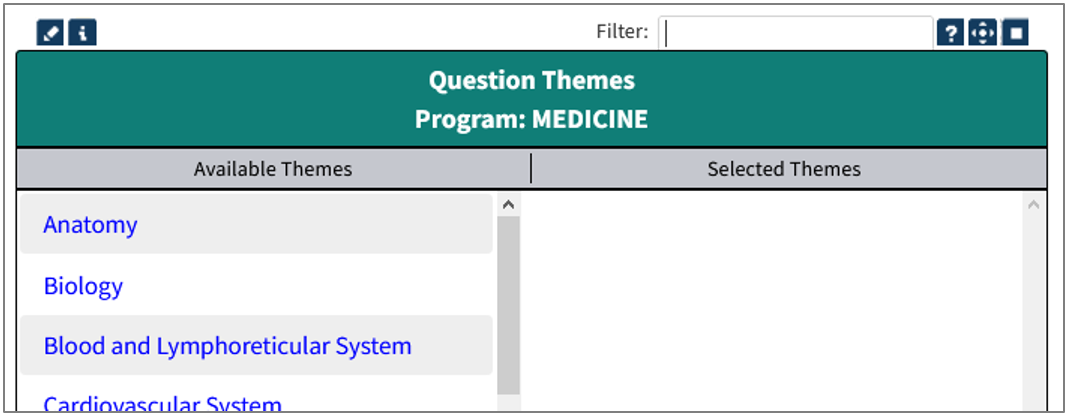
9/24/2020
The DaVinci Education team has been at work rolling out some new features in Leo:
Course-wide discussions:
Now you can host discussions in Leo across multiple sections of the same course in the same academic year. Just navigate to the Course Template level of your Course and select Add New Discussion from the menu. You’ll be able to choose which sections of the course should participate.
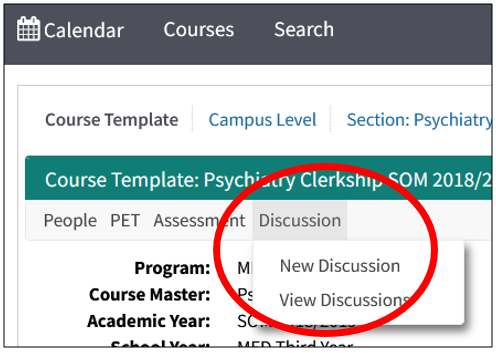
Embed images inline in discussion posts:
While you’ve always been able to attach local images - or embed images from the web - now you can easily embed images you’ve uploaded yourself. After you upload your image, you’ll see a new option to “Embed” - which will add your image into the post you’re editing. From there you can resize the image, move it around, and customize your presentation however you want.
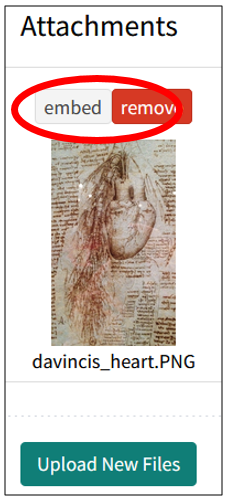
These new reports are available at the Course Template level:
- The Faculty Listing shows you all of the faculty in the course, the sections in which they are participating, what type of faculty they are, the number of events with which they are associated, and their hours for tracking financial time. This report also provides access to a detailed listing of an individual faculty member’s events.
- The Student Listing shows all the students, their affiliation, and the sections they are enrolled in for that specific academic year.

8/28/2020
We’ve made completing evaluations in Leo more intuitive. Now when filling out or summarizing an evaluation, it’s easier than ever to make sure that all required questions have been answered.
When completing an evaluation:
As you take the evaluation, each item is clearly labeled as Answered/Unanswered and Required/Optional. These labels, and your progress bar, respond dynamically as you complete each question. The “Submit” button will only appear once you’ve completed all required items.
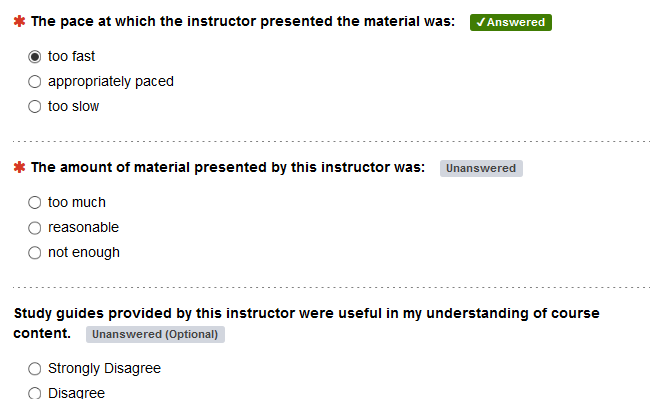
If you’re working through several evaluations, you can submit as soon as you’ve completed all required items in any one of those evaluations - but if you left a required item unanswered in any of the rest of them, Leo will stop and cue you to go back and complete it.
When summarizing an evaluation:
If you attempt to summarize an evaluation, but there are responses missing on a required question in the evaluation, Leo will stop, tell you, and ask you what you want to do:
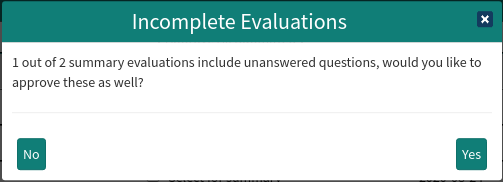
If you go back to the evaluation with unanswered questions, you’ll find each unanswered item flagged with a helpful link you can use to jump right to each unanswered question.

Also recently added:
Want to set up recurring evaluations for a specific type of event in a course? When using the "Auto-Assign" tool for setting up evaluations, you can now filter events by Event Type.
After you select your dates, you can use a handy drop-down menu of the relevant Event Types to narrow down your search.
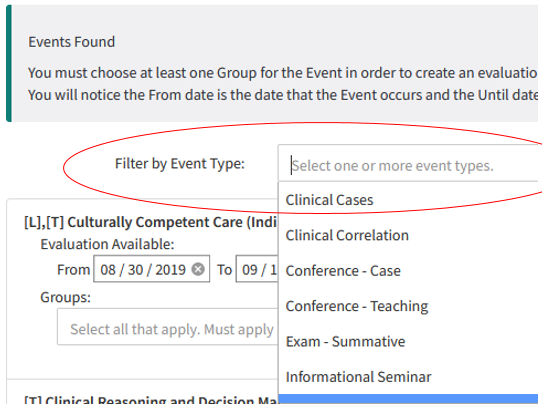
7/21/2020
We’ve rolled out a number of small but important updates for Leo:
- Curriculum Inventory (CI) Keyword Adjustments for COVID-19 Reporting:
In order to facilitate the identification of COVID-19 Remote and COVID-19 Altered events, we have implemented a function to map Themes in Leo to CI Keywords. This feature requires opting-in per Theme, so you will need to choose "Include in CI" for each Theme you wish to include in the report as a Keyword.
The exact path to accessing your Themes will differ, depending on whether your system is configured to use Theme Collections and Theme Sets. The following path is for a system that is using Collections and Sets (i.e. all three levels), but your path might be shorter: To opt-in a Theme, go to Admin Bar > CURRICULUM MAPPING > Organization > Themes > Select your program. Then click on the number in the “Theme Set Count” column next to the appropriate Theme Collection. Then click on the number in the “Theme Count” column next to the appropriate Theme Set. You will see a new column for “Include in CI” where you will have the option to check a box if you want that Theme included in the CI.

You may include Themes beyond the two official Keywords requested by the AAMC: COVID-19 Remote and COVID-19 Altered. Themes you have opted in will then show as Keywords on your CI Preview Report in Leo (Admin Bar > CURRICULUM MAPPING > Curriculum Inventory > Reports > Preview) as well as the official CI Verification Report
Remember you can view our extensive CI guidance in the Leo User Guide.
- Pop-Ups for High Priority Messages
Now when you select “Highest” priority when creating an Announcement or Message, that message will appear as a pop-up for users when they first login.
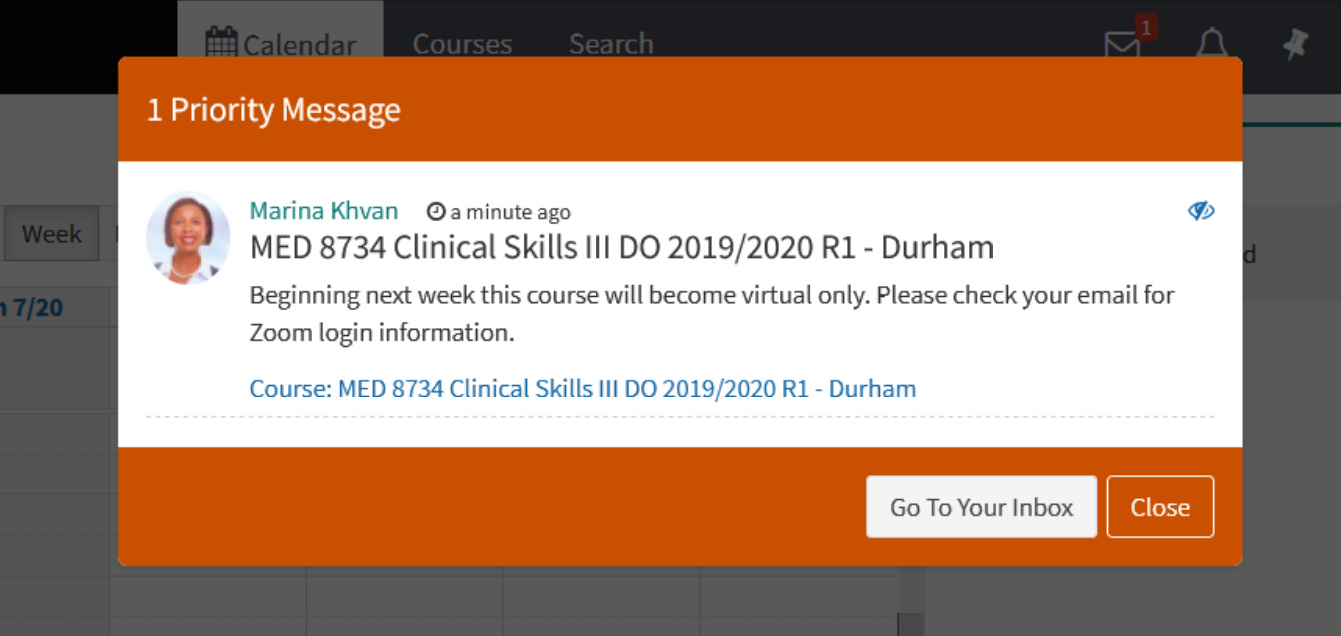
TIP: If you have a high priority message to manage, remember that you can see who has viewed it in Leo. Just look for the link labeled “Who has read this?” on any message.
For more information, please see the Leo User Guide article on highest priority messages.
- Evaluation Question Values:
We’ve increased the flexibility of values in Leo evaluations to include decimals. You can define your question values with accuracy down to the hundredths place.

For more information on editing responses, including the value, please see the Leo User Guide article on editing an evaluation.
- Long Event Grading
Now Graders in Leo have the same ability to open assignments and score them in Long Events as they have in regular events.
6/11/2020
We’ve rolled out a few highly-requested updates for the Leo Gradebook.
Display student alpha score and numeric score together: When using the matrix to display a letter grade or other descriptors, you’ll now see the “Grade” column accompanied by a “Score” column which indicates the number behind the alpha designation.
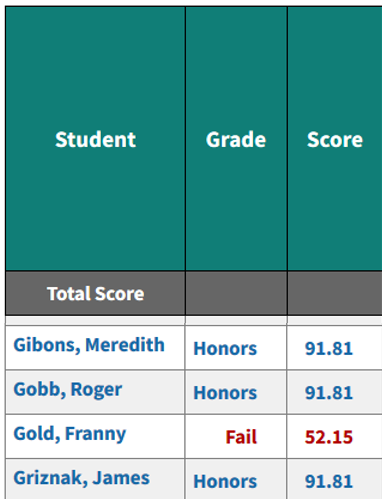
Manually enter final grades: Clicking on the number in the “Score” column now pops up a window where you can override the calculated score with a manual entry.
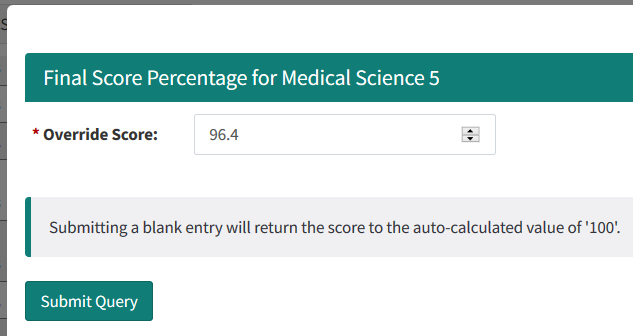
Import grades - including final grades - via CSV upload: Now you’ll see two new options at the top of your Gradebook: Download CSV and Upload CSV. You can use the downloaded CSV as your template for creating your upload CSV.

For more details on these Gradebook features please see our comprehensive User Guide.
6/10/2020
DaVinci's statement on social injustice and racial inequality: https://www.davinci-ed.com/resources/davinci-education-statement
5/21/2020
To save you time and help you work more efficiently, we are updating Leo this weekend with a new interface for most report screens. The new interface for Leo reports provides several helpful upgrades including:
- Sort by any column
- Search report results
- Toggle columns on and off
- Cleaner, simpler menus
Let’s consider, for example, a report looking at all of the Events in a Section.
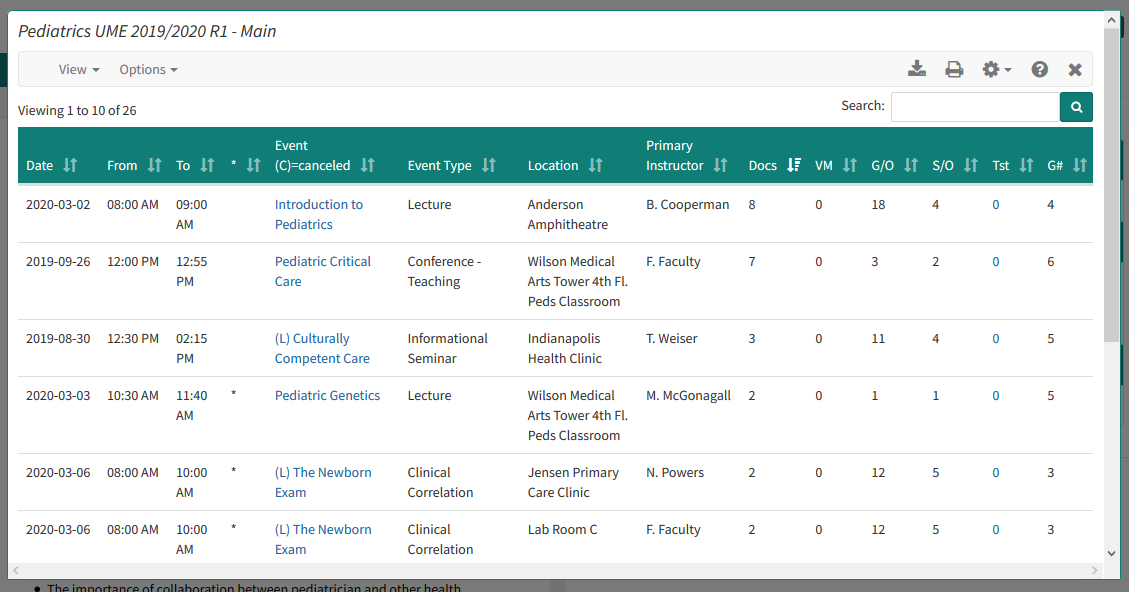
In this example, we get 26 events. What if we only want to know which Lectures have Docs?
Now we can type “Lecture” into the Search window to narrow the results - it will filter as you type:

We can click the “Docs” column header to sort in ascending or descending order.

We can even toggle off every column except the Event date and time info and the # of Docs

The result is a tidy report that shows us just what we wanted.

We can also create a PDF of our filtered report using the Printer icon.
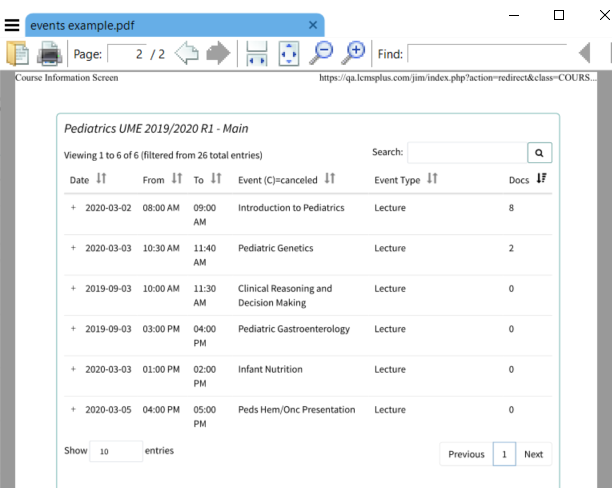
For more information about new report options in Leo, check out the complete article in our comprehensive User Guide.
These changes have been installed in your Training system, so you can check it out right away.
5/18/2020
We’re pleased to let you know that Leo’s been updated with more timesaving features:
New Tool to Automatically Create and Assign Evaluations
Now you can easily set up Evaluations for multiple events of a given Event Type in a Section and assign them to students in bulk!
Select the desired Course Section and select Assessment > Auto Assign Evaluations

Select the Evaluation template you want to employ and give your new Evaluation a title. Choose a date range for the events you want students to evaluate.

Leo will show you all the events that match your search criteria, as well as any associated Student Groups. Select the appropriate groups, and click “Submit”.
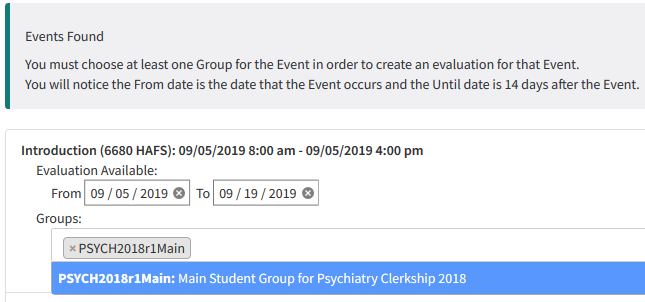
That’s it! Students in those events will be assigned the appropriate evaluation.
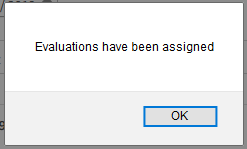
For more information about all our Evaluation management options, see our User Guide.
New Options for Reminders in Long Events and Long Event Assignments
When creating or editing any Long Event, you can now create a customized reminder message to go out via email before the Long Event concludes. You can even specify how long before the Long Event concludes you'd like your reminder to go out.
From the Section screen, go to Events > Long Events > Management and click on the name of the Long Event to create or edit your reminder.
You can also now create a reminder tied to a specific Assignment within a Long Event. Just specify how long before the assignment due date you want Leo to remind your students.
From the info screen of your Long Event, click on the Assignments dropdown menu and select Manage Assignments. Click on Create New Assignment or the name of an existing Assignment to create or edit your reminder email.
For more information, see our comprehensive User Guide articles on Long Events and Assignments.
There are more new features right around the corner, so keep an eye out for more updates soon.
4/20/2020
As promised, we’ve now updated your training system with another round of new features for the Leo evaluation system. These will be introduced to production systems this weekend, joining the dozen new evaluation features introduced last weekend.
Because this update includes a new look for evaluations, we wanted you to have the opportunity to preview the changes before they go live. These changes are designed to make evaluations more intuitive. Users already familiar with evaluations in Leo shouldn’t require any additional training - the process of completing an evaluation should be easier than ever. For more information, please visit the Evaluation chapter in the Leo User Guide.
New User Interface for completing Evaluations
Leo Evaluations have a new, responsive interface that displays beautifully on screens of any size. We’ve added some new navigational aids to make Evals easier to use:
- Clear links for navigating between multiple pages and/or evaluatees
- Clear links for submitting completed evaluations
- The “header” section with a profile photo of the evaluatee remains visible as you scroll.
- More clear visual indicators for which questions are required
- Prominent progress bar to indicate how many prompts remain
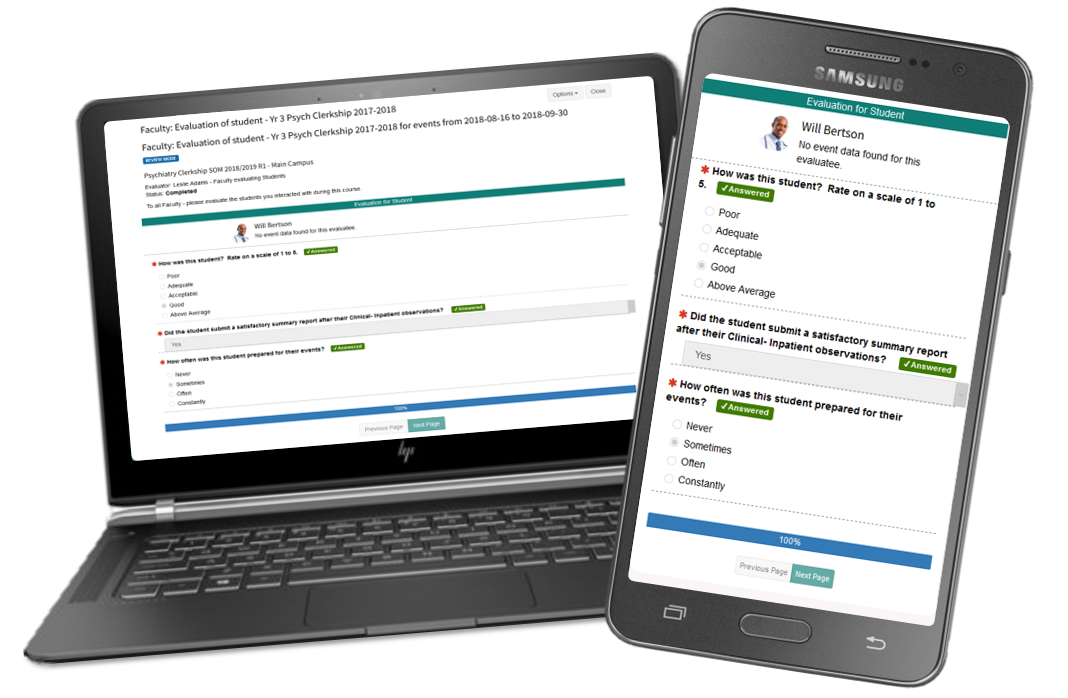
Add multiple recipients to email triggers
Leo allows you to set up customized triggers that send email notifications depending on an evaluation response. Now you can add more than one recipient to each trigger. Search for any user to add them to the trigger, or click X to remove them.
ASSESSMENT > Evaluations > Email Triggers
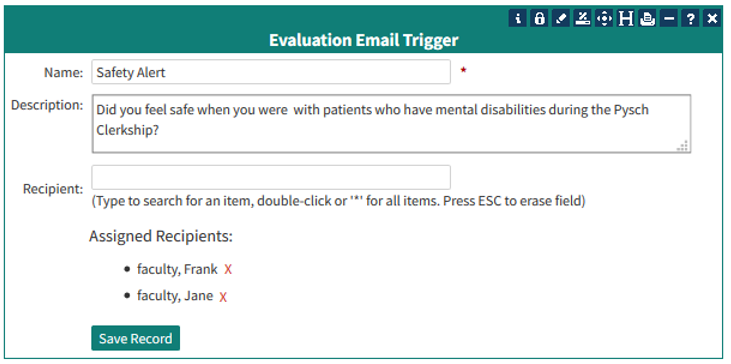
EA1-T20 Easily copy a question in an evaluation
We’ve added another new link in the Evaluation Editor that you can use to copy any question. Click Copy next to any question, and a new copy of that question will appear in the list, labeled COPY. Find this option next to the new 1-click Delete option we also added in last week’s update.

4/13/2020
The DaVinci team has introduced a number of timesaving improvements to our Evaluations. All of the following new features have been drawn directly from submissions to the Leo Feature Request Forum - and all of them are now available in Leo.
Stay tuned for even more information about requested Evaluation upgrades - including updates to the user interface - in the next few days.
Incomplete Evaluations Report
Now you can find all outstanding evaluations, filtered by Program, Eval Type, Year, Campus, Course Template and/or Section. Select the evaluation form you want to use, and download your results.
ASSESSMENT > Evaluations > Incomplete Evals

Customize the text in eval reminder emails
You can now add your own text to the automatic reminder emails that go out with evaluations. Under the Course Section screen, you’ll find this feature with the other Course Messages options.
[Section Info Screen] > Gear > Edit Descriptions
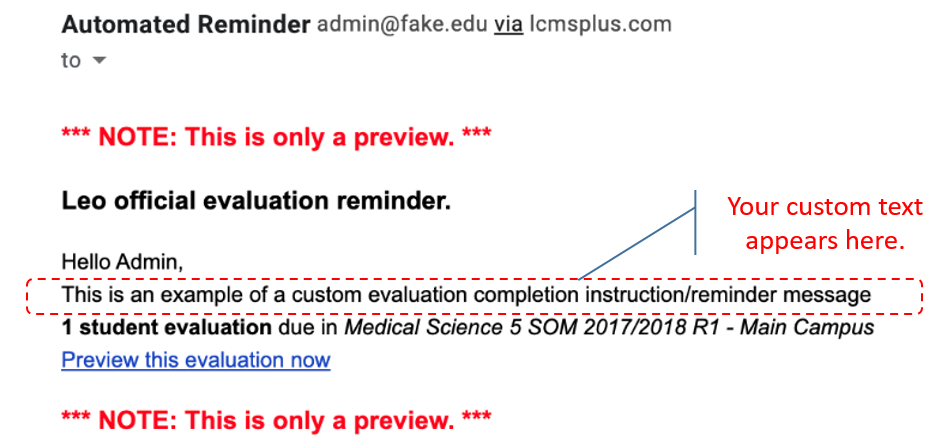
Quickly delete a question
We’ve added a handy link in the Evaluation Editor to allow you to delete questions with one click. Open any Evaluation and this option will appear at the right hand side of the screen.

“Archive” old evaluation forms
Is your list of Evaluations getting too long to manage? We’ve added an easy way to hide, or “archive” those old evaluations, that removes them from the Eval Listing. The new checkbox lets you clean up this report by quickly clicking multiple evaluations. If you archive an Evaluation in error, the new filter for Archived records at the top of the screen allows you to restore it by unchecking the box.
ASSESSMENT > Evaluations > Eval Listing

Remove the option for clinical faculty to select their evaluatees
If you’re using the evaluation email reminders, you might not want your clinical faculty to be able to change their assigned evaluatees. Now you can opt to remove this option from their screen.
ADVANCED > Account Manager > Modules > Evaluation Settings > [Program Name] General Evaluation Settings > Hide the ‘Add/Remove’ link for selecting clinical evaluatees.
Exclude incomplete evals from summary reports
Now you can remove incomplete evaluations from all summary evaluation reports. This may improve the accuracy of your data, as it removes evaluations that are still in progress or erroneously completed. On the Summary Reports screen, you can toggle back and forth between including or excluding incomplete evaluations - the title at the top of the screen will reflect your selection.

[Section Info Screen] > Assessment > Evaluations > Summary Reports > Exclude Incomplete Evaluations
Show photos on evaluatee screen by default
Your clinical faculty may benefit from seeing student pictures on the screen where they select evaluatees. Now you can select the option to display student photos by default.
ADVANCED > Account Manager > Modules > Evaluation Settings > [Program Name] General Evaluation Settings > Show Photos of Clinical Evaluatees by Default
Reopen multiple evaluations at once
Now you can reopen all of the completed responses related to a single evaluation. (Note: you must have the option enabled in your Account Manager to allow completed evaluations to be reopened.)
[Section Info Screen] > Assessment > Evaluations > Select desired eval type > Click the number in the “Done” column to view completed evaluations > Click “Re-Open All” at the top of the screen.
Improvements for Evaluators-of-Record
Now the evaluators-of-record for a Course can approve submitted evaluations in bulk with a lot less clicking. Instead of opening each evaluation, you can click a new “Approve All” option on the eval workflow screen. The “byTypebyLink” step has also been removed from the process.
[Course Template Info Screen] > Evaluations Tab > Select Desired Evaluations for Review > Approve All Submitted

A new column in the Export Eval Data tool to show status
You can use the Export Eval Responses tool to export all summary evaluation data from Leo - filtered by Program, Eval Type, Year, Campus, Course and Section. This export can be delivered as either a CSV or in the format of a custom SQL query that you can use with an ODBC connection. Now we’ve added an additional field to this data export so you can also view the approval status of each evaluation.
ASSESSMENT > Evaluations > Export Eval Responses
Evaluation Previews refresh every time
When editing an evaluation, clicking the “Preview” (eyeball) icon in the upper right corner of the screen allows you to see what your evaluators will see when they access the evaluation - and it allows you to interact with the questions in the evaluation. Previously, Leo would continue displaying those interactions if you clicked back and forth between the editor and the preview - but that caused some confusion, particularly when designing evaluations with triggers. Now, every time you click over to Preview, Leo will let you start fresh.
3/27/2020
The DaVinci Education team has continued to work around the clock to build additional improvements to our Discussion Boards, which are integrated with every event and course in Leo.
Attach images and files:
Now in addition to embedding HTML content (see our recent post with great ideas for embeddable HTML content) - you can upload images or other documents to any post or reply.
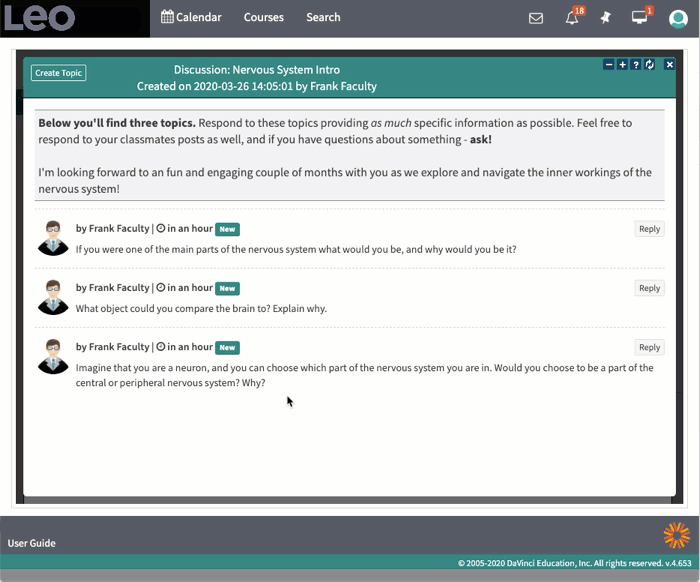
Improved Style:
We've improved the look of the Discussion Boards to make them easier to navigate and easier to read.

Editing and Deleting:
Course Coordinators or Directors (or administrators) can now:
- View, edit or delete all posts and replies in a discussion.
- View all deleted posts and replies and restore them.
- See when a post or reply has been edited.
Students can now:
- View, edit or delete their own posts and replies in a discussion.
- See when a post or reply has been edited.
- See a "Content Deleted" message in the place of a removed post.
Participation Tracking:
We’ve simplified the “Participation Report” - click the checkmark icon to see which students have participated in each Discussion.
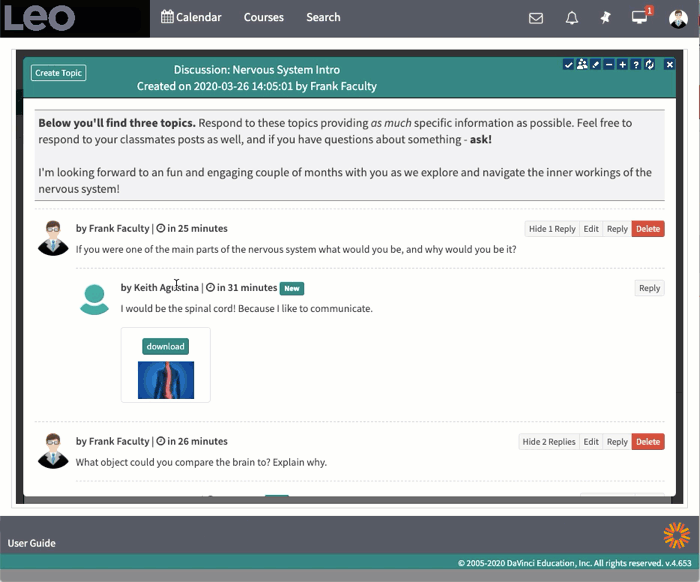
Thank you for the opportunity to support you during this difficult time. We look forward to introducing even more time-saving improvements to assist your remote instruction in the days and weeks to come.
3/16/2020
If you are looking for a solution to manage the release of Match Day letters to your students online while they are no longer on campus, DaVinci Education can help.
Leo provides a method for uploading multiple PDF documents for students, while keeping them hidden until the desired release time.
This is not the original intended use for these features in Leo - but, like you, we are adapting the tools we have to work with the challenges of the present moment.
*If you would like to find out more about how to use Leo to host your Virtual Match Day, please contact us as soon as possible using this link; no later than 5:00 PM EDT on Tuesday, March 17.*
Our team will show you the available option, and if you decide to proceed, we will review your setup in the days leading up to the big event, including checking your server capacity for handling multiple downloads by students all at once.
We can also walk you through the setup by phone or teleconference - and we'll be standing by to offer support on Match Day.
3/13/2020
In response to the emerging need to host online instruction, the DaVinci Education team has rolled out some small but important enhancements to help you get more out of Leo's integrated Discussion Boards:
- We've updated the terminology we use in order to make navigating discussions more intuitive. "Top level posts" are now called "Topics”. From any event or course screen, you can start multiple Discussions, which consist of multiple Topics, to which students and faculty can post Replies.
- In those Topics and Replies, we've updated the user tools so you can now embed video and any other kind of HTML content. Toss in a poll or video, embed a chat - there's lots of neat free or low-cost options for increasing interaction within your discussions (or events) right in Leo.
- Users can now edit their own Topics and Replies after posting.
- Additionally, we've made some under-the-hood improvements to our Activity report (attached to the Bell icon), to help users more easily view the most recent notifications - for example, when Discussion Board content has been updated.
For more information and step-by-step instructions on how to use the Leo Discussion Boards, please visit our User Guide.
We have more updates coming soon and will keep you posted.
3/12/2020
The team at DaVinci Education wanted to share some resources we’ve created on distance learning that may be useful as you and your teams think about how to move forward with delivering your curriculum online during this public health crisis.
Please visit our newest blog posts:
- Strategies for Leveraging Distance Learning Tools
- 9 Best Practices for Distance Education
- Using Video in the MedEd Classroom
Each article highlights useful information for managing your educational program remotely, including how to utilize Leo to facilitate online learning.
Our User Guide is also a helpful resource, with step-by-step instructions on how to utilize features in Leo to deliver content, manage communication, and share materials online. We have put together a list of useful features and articles to help you quickly find the information you may need.
Our team has been working quickly to develop some helpful enhancements to Leo’s integrated Discussion Boards and we will be introducing some new features in the coming days. We will send updates as this new functionality is rolled out. Additionally, there are many online tools that can be used seamlessly alongside Leo to further support distance learning and content delivery. While some of these resources are shared in the aforementioned blogs, we will be sharing a curated list with more information about how to use these tools with Leo in the coming days.
Please let us know via our Help Desk if you have any questions, or would like to talk to us about how to get the most out of Leo during this time. Our team of trainers and educators are ready and happy to help. We will continue to communicate and share resources as we respond to the situation, and do not anticipate any disruption in our ability to continue to serve you.











